#trait: ancient holy warrior
Explore tagged Tumblr posts
Text

Imperialdramon: Paladin Mode Ace BT17-077 Alternative Art by tyuga from BT-17 Booster Secret Crisis
#digimon#digimon tcg#digimon card game#digica#デジカ#digisafe#AA#BT17#imperialdramon paladin mode#ace digimon#tyuga#digimon card#Lv7#color: white#color: blue#color: green#type: vaccine#trait: ancient holy warrior#type: free#num: 03
106 notes
·
View notes
Text
Mandalorian tenets or the six actions.
Early Mandalorian culture, originating with the ancient Taung species, was believed to have begun as a religious warrior society, War was practiced as a form of ritual worship to their multiple gods and because of this, many of the Mandalorians' earliest conflicts were seen as holy wars and their warriors known as the Mandalorian Crusaders.
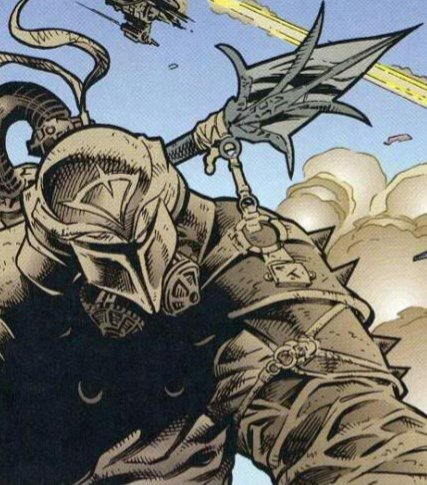
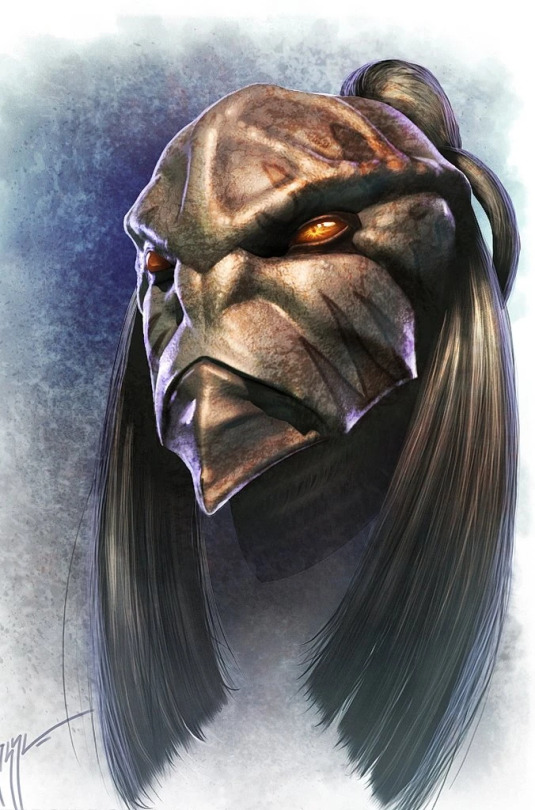
After the Great Sith war where most of the Taung had perished , the Mandalorians began accepting beings of other races and species into their culture and transforming what it meant to be a Mandalorian. Those who considered themselves Mandalorian were bound by a single, unifying culture rather than any one race, and they believed that an individual was defined by their actions rather than the circumstances of birth.
Resol'nare
Young Mandalorian children were taught a rhyme to help them learn the tenets of the Resol'nare (basic: six actions) These six tenets defined what it meant to be a Mandalorian, and any who wished to be considered as such was expected to follow them.
Ba'jur, beskar'gam, (Education and armor)
Ara'nov, aliit, (Self-defense, our tribe)
Mando'a bal Mand'alor — (Our language, our leader)
An vencuyan mhi. (All help us survive.)
This code is self-perpetuating and was directly responsible for ensuring the survival of the Mandalorian culture and society.
Wearing the armor (beskar'gam or ''iron skin'')
Once Mandalorians reach adulthood, they assemble a suit of armor that suits their needs and skills. It is both a tool and a symbol of their cultural identity. Aside from its defensive capabilities, armor served another function: in a group formed from so many different species, often times it was only the armor that displayed an outward sign of the culture that bound these individuals together. The paint scheme of a Mandalorian's armor occasionally represented a soldier's state of mind, or their personal mission.

As many soldiers preferred the inconspicuousness afforded by camouflage, Mandalorians believed in the saying:
"It's one thing to see us coming, it's another to do something about it."
Speaking the language (Mando'a)
While most Mandalorians know and speak Basic and other languages, all are raised speaking Mando'a, the language of the Taungs. When among themselves, they speak Mando'a almost exclusively. The language itself is very fluid and simple, reflecting the culture of which it is a part, and like the culture, it has changed very little over the centuries.
Mando'a was often thought of as easy to learn, a trait highly desirable in a culture that regularly adopted adults from numerous races and species. But there were difference speaker of Basic had to adjust, including Mando'a's expression of tense, and its gender-neutrality.
It was not unheard for Mandalorians to speak other languages such as Huttese and Basic alongside Mandalorian as it was necessary to communicate with others when working as a mercenary or bounty hunter.
Defending oneself and the family
While the Mandalorians are best known as a warrior culture, they are also strongly family oriented. Each member of a family is expected to protect the others, garaunteeing their survival and through this, ensuring the survival of the clan and culture.
Adoption was extremely common in Mandalorian culture, to the point where even adults could be adopted. Because of the Mandalorians' constant connection to war, widows and orphans became an inescapable fact of life.
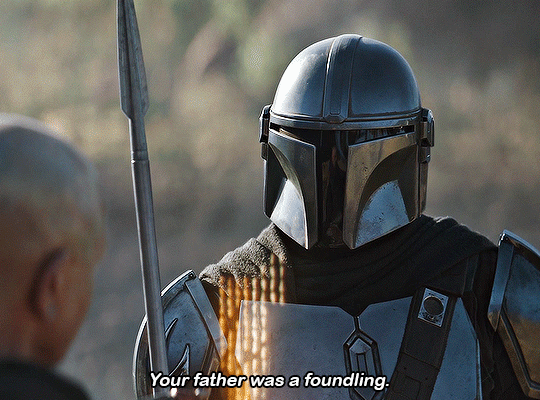
Contribute to clans welfare
Each individual and family is expected to contribute to the welfare and prosperity of their clan, which in turn helps provide for the family and individual as needed. This act is far from the socialist prop it first seems, as it is a neccessity for a society that spends a great deal of its time at war to provide for such neccessities as food, shelter and manufactured goods when a large number of a clan's adults are on other worlds fighting.
Raise children as Mandalorians
It is a Mandalorian's responsibility to raise children in the traditions of their culture. However this is not simply an imperative to breed, as it might seem on the surface. Mandalorians often adopt their children, caring very little for blood lineage and bowing to the neccessities created by their lifestyles as nomadic warriors. This act is a mandate to perpetuate the culture, as are the majority of the Six Acts, by passing it down to both offspring and adopted war orphans.

Rally to the cause of the Mand’alor
While the social structure of the Mandalorians is very simple, revolving around family and clan, each clan and family answering to itself, in times of war all families and clans are expected to answer a call to war by the Mand'alor, the leader of the Mandalorian people.
The old and the new way.
In order to retain their heritage in the face of outside influence, Mandalorians placed a high value on rigorously carrying out the Resol'nare's tenets in a daily manner. However, interpretation of the Resol'nare differed, and at least one group of Mandalorians, the New Mandalorians, potentially followed an alternate interpretation of the Resol'nare by doing away with personally-owned sets of armor and refusing to aid the Mand'alor.

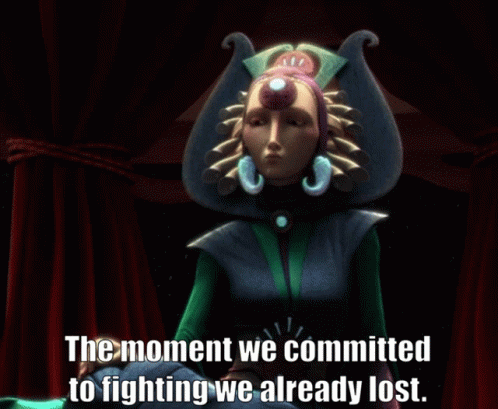
The New Mandalorians was the pacifist movement who placed great importance on the virtues of pacifism, neutrality, and nonviolence rather than martial prowess and military strength as the Old Mandalorians did. They were led by a Duchess of Mandalore up until its dissolution following the coup in 19 BBY.
Similar to Death Watch, the Old Mandalorians were exiled from Mandalore, but unlike their Death Watch counterparts, did not seek vengeance on the New Mandalorians. Instead, the Old Mandalorians resettled in other parts of the galaxy and worked for the highest bidder, maintaining their Mandalorian warrior heritage as bounty hunters, mercenaries and other professions.
"Here's why you can't exterminate us, aruetii. We're not huddled in one place—we span the galaxy. We need no lords or leaders—so you can't destroy our command. We can live without technology—so we can fight with our bare hands. We have no species or bloodline—so we can rebuild our ranks with others who want to join us. We're more than just a people or an army, aruetii. We're a culture. We're an idea. And you can't kill ideas—but we can certainly kill you."
― Mandalore the Destroyer
#the mandalorian#mandalorians#mandalorian culture#mandalorian armor#foundlings#the old way#new mandalorians#satine kryze#mando'a#star wars#legends#mandalorian tenets#six actions#clans
217 notes
·
View notes
Text
So I don't change much when it comes to the warriors themselves. I'll update in a different post, I haven't planned out to much lore hahahah. Most of this is just like phrases or books or stuff like that pertaining to the story. (PLEASE NOTE - I am not religious and my knowledge on religion is either ancient civilizations or what I've been exposed to which is Christianity. I do apologize) ALSO - I obviously don’t support some of the standards listed below but like I’m creating a sexist religion for plot sooooo)
Phrases
• Oh My Irene - Oh My God (Same as cannon), I feel this would change names depending on the region you're in. But Irene is the main one used) (ie, regions who ship Esmund would use his name and Irene's interchanging)
• Holy Divine - Jesus Christ (I made this up. I think it's funny hehe)
Books
• The Divine is the main book which covers the life of Irene and her wars, sayings and just life. This book is widely used in Ru'Aun. It has been altered over the years
• each region has books that paint their gods in good light. Though characters in different regions aren't exposed to those books.
• They are unknown books, "lost to time" that depict the wider picture of those years of history (they probably live in Hyria's attic let's be honest) (she probably wrote them, let's be honest)
Desired Traits and Standards/Culture in Ru'aun Based on Religion
• Giving, helping your family, neighbors and foes. It's a huge part of the religion. Irene is seen as the matron and so you must be as understanding as possible. This message is slowly lost overtime.
• Purity. Mostly enforced by places like O'Khasis. Purity is a huge fixation on the religion. Whether it's sexual or with ideas or violence. You're expected to only do "dirty" things when needed
• motherhood is heavily emphasized. Caretaker, nurture, protect. Women are seen as these bringers of life who radiate kindness and love their children.
• Violence being needed. Only take lives when needed and when there is no other way out. Try to be diplomatic. O'Khasis and other powerhouses disregard this.
• The standards of giving allow for good trade amongst the land. O'Khasis uses this standard to mooch off of it's civilians by taking as much as they can from them. Other places like Meteli or Phoenix Drop take this saying to heart
• Saving yourself for marriage and being a homemaker is emphasized greatly to the higher classes of wealthy villages and kingdoms
• Occults like Werewolves and Meif'was are looked down upon, mostly by powerhouses. O'Khasis deems Meif'was as immature and that their magicks aren't "beautiful" like Irene's - that they're naive. Werewolves are seen as barbaric and their polyamory is frowned upon.
• Shadow Knights are hated in the region. Valued by power houses for their strengths. They are usually killed on sight in villages and strong followers of the Divine will kill themselves when brought back as Shadow Knights due to the disgust at themselves.
• All powered beings besides the Jury are looked down upon. Even if used for their strengths. Places like O'Khasis doesn't value their humanity.
16 notes
·
View notes
Text
Werewolves in Ancient Warfare
Werewolves show up in a lot of different types of ancient war stories. They were both scary mythical creatures and symbols of the wild power and supernatural skill that fighters tried to embody. From the cold Norse lands to the dense forests of Eastern Europe and beyond, these stories show that people have always been interested in the idea that humans can get past their natural limits by calling on animal power.
When it comes to the Norse, the berserkers and úlfhéðnar (wolf coats) are two of the best examples of this. The berserkers, whose name derives from the word "bear-shirts," were fighters who wore bear skins and were thought to be so angry that they could almost not be hurt in battle. They were known for being very strong, not feeling pain, and becoming enraged very quickly, which made them fight like wild animals. Similarly, they wore wolf coats and were believed to possess the wolf's spirit. People thought that these fighters had sharper senses, were very strong, and were always hunting. Historical accounts and sagas recount the amazing feats these fighters accomplished, seemingly beyond human comprehension. People often attribute their strength to divine intervention or a supernatural change.

The link between the berserkers, the úlfhéðnar, and the god Odin emphasizes the spiritual side of these changes. Odin was a god of war, magic, and knowledge. People often depicted Odin with wolves and ravens. People saw the berserkers and úlfhéðnar as his chosen fighters because they were empowered to go beyond human limits and connect with nature's basic forces. This connection to the gods not only raised their status as fighters, but it also gave the idea of turning into a werewolf a holy and scary quality.
King Lycaon's story is the best example of lycanthropy in Greek and Roman mythology. Lycanthropy means changing into a wolf. The story goes that Lycaon, king of Arcadia, tried to trick Zeus by giving him food made from the flesh of a child who had been killed. As a punishment, Zeus turned Lycaon into a wolf and threw him out into the wild to live as a wild animal. The mythological background of the word "lycanthropy" underscores the connection between unkindness towards others and the loss of humanity, symbolized by the transformation into a wolf. Even though it has nothing to do with war, the concept of lycanthropy led to later ideas about fierce fighters who seemed to channel the spirit of the wolf in battle. People still thought that fighters had wolf-like traits, which meant that individuals who were very violent and strong might be channeling a wolf spirit and blurring the lines between humans and animals.
The ancient Gauls also believed that warriors could change, especially through their druidic practices. The Druids, as the spiritual leaders of the Gaulish tribes, were thought to know a lot about nature and be able to change their appearance. Some warriors believed that they had a strong link to nature because they could change into wolves. People believed that the warriors possessed the cunning, power, and wildness of wolves, indicating that these transformations were not merely physical. They were also spiritual. People feared them in battle not only because they were skilled fighters but also because they believed they possessed magical powers that gave them an advantage over ordinary men.
The volkodlak, or werewolf, was both feared and adored in Slavic mythology. People thought that Slavic fighters, especially those who could turn into wolves, were almost unbeatable. Some believed the volkodlak to be a powerful entity capable of transforming into a wolf in times of need or danger. People believed that God guided these changes, or that they demonstrated the fighter's strength and connection to the spirit world. People who were volkodlak had enhanced awareness, superhuman strength, and unmatched resilience, which made them very dangerous in battle. Not only did people fear and respect these fighters for their strength, but also for their perceived connection to supernatural forces of nature.

The idea that fighters can change into wolves is common in all of these different cultures. It comes from a deep-seated belief in the power of nature and the idea that humans can go beyond their limits by connecting with basic forces. People often view animals resembling werewolves as the epitome of the best warriors, as they embody a deep connection with nature, possess extraordinary abilities, and inspire such fear in their enemies.
These stories also underscore the notion that these transformations brought forth both positive and negative outcomes. Being a werewolf gave warriors a lot of power and skills that helped them win battles, but they also ran the risk of losing their humanity. It became harder to tell the difference between man and beast, which made people wonder about power, control, and the price of having such supernatural powers.
6 notes
·
View notes
Text

The dead of Loraille do not rest. Artemisia is training to be a Gray Sister, a nun who cleanses the bodies of the deceased so that their souls can pass on. She’d rather deal with the dead than the living, who point and whisper about the odd girl who was once possessed by a violent spirit. When her convent is attacked by possessed soldiers, Artemisia fights back by awakening an ancient spirit bound to a high saint’s relic. It is a revenant, a malevolent being now whispering in her head. Wielding its extraordinary power almost consumes her in body and soul. But death has come to Loraille, and only a vespertine, a priestess trained to wield a high relic, has a chance of stopping it. As Artemisia investigates a mystery of saints, secrets and dark magic, an ancient evil is stirring. Can an untrained girl, tormented by the burden of containing the revenant’s devouring power, have any hope of defeating it?
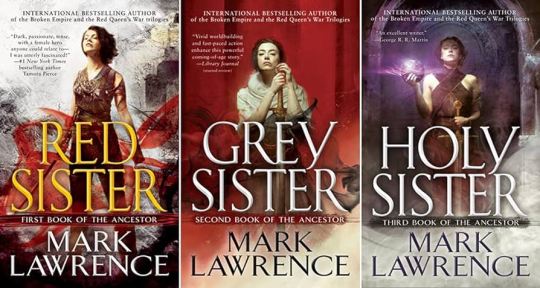
The complete Book of the Ancestor Trilogy, a stunning epic fantasy series by Mark Lawrence! Red Sister: At the Convent of Sweet Mercy, young girls are raised to be killers. In some few children the old bloods show, gifting rare talents that can be honed to deadly or mystic effect. But even the mistresses of sword and shadow don’t truly understand what they have purchased when Nona Grey is brought to their halls. Grey Sister: Behind its walls, the Convent of Sweet Mercy has trained young girls to hone their skills for centuries. In Mystic Class, Novice Nona Grey has begun to learn the secrets of the universe. But so often even the deepest truths just make our choices harder. Before she leaves the convent, Nona must choose which order to dedicate herself to—and whether her path will lead to a life of prayer and service or one of the blade and the fist. Holy Sister: The ice is advancing, the Corridor narrowing, and the empire is under siege from the Scithrowl in the east and the Durns in the west. Everywhere, the emperor’s armies are in retreat. Nona Grey faces the final challenges that must be overcome if she is to become a full sister in the order of her choice. But it seems unlikely that she and her friends will have time to earn a nun’s habit before war is on their doorstep.
This two books are very similar: both the protagonists, Artemisia in Vespertine and Nona in The Book of Ancestor, are orphans raised in a female-dominated holy place, trained in their ways. Both became possessed by devious spirits at some point of the story and both are reluctantly call to save the day. Both the characters are highly influenced by the traumas they endured (physically and psychologically) but while Artemisia — at the beginning of the book — is more isolated and lacks of friends, Nona, despite her more feral nature, is more easily going with people who became loyal friends to her. Both in Vespertine and Book Of Ancestor Trilogy there's a great curruption in the secular and religious hierarchies, but while in Vespertine those religious authorities are victims in their own way, in Book Of Ancestor the corrupted spiritual leaders are more mundane and their action are plotted by the political plans and ambitions of the royal family members.
The main difference is that Artemisia is not a warrior herself: when the convent is attacked by possessed soldiers (Revenants), she takes up a reliquary kept by an elderly nun and, thanks to the spirit that resided there, she runs into the fight, saving the day. Afterward, she is arrested by a priest — probably a future love interest — in conflict with himself and his religious beliefs.
There are a handful of supporting characters with their own special traits: a soldier who experienced a similar trauma to what Artemisia went through as a kid, whom she's able to connect with and help; a fellow nun from the convent who is very different from Artemisia (I appreciated their enemies-to-friends relationship, and her cleverness); and a grouchy but powerful elder who you can't help but adore (which is very similar to the cunning Abbess who took Nona under her care) .
The Revenant is an interesting character, who is supposed to be evil, and it is in some ways, but it’s also caring: it's the revenant that taught Artemisia to take care of herself, to consider herself worthy of being cared for.
Artemisia isn't as kickass as Nona ––many of the badass moments were due to the revenant controlling her––but she has her strengths. I appreciated that she grew to trust and care for the revenant despite how she was raised, and that she was able to push out of her comfort zone at times. It's nice to see how people in similar situations can turn out differently based on their individual experiences.
Book of the Ancestor, on the other hand, follows the growth of young Nona Grey, adopted into a convent of nuns known for their martial and magical skills. Nona and her friends must learn how to utilize the magic of their world to hopefully save their empire. Nona’s story, as she taps into her own potential and makes peace with herself — and the violence within her — is well-written and the self-immersion in her thoughts is cathartic and immediate.
The world of Book of the Ancestor deserves special attention. It is, in my reading, wholly unique. Giant ice sheets are slowly covering the world, squeezing nearly the entire population of the world into a narrow strip of land. It's a fascinating concept and becomes a major part of the series.
Overall, I enjoyed the series. It's fast-paced with characters that I came to enjoy (more on that in a moment). The books have a fun magic system that leads to excellent pay-offs in each of the books, and Lawrence plays with time, too, keeping the tension high throughout the stories.
I'm not a huge fan of magical academy tropes, which are very prevalent in Book Of The Ancestor (like the first book of the The Poppy War Series by R. F. Kuang). There are occasional moments of familiar tropes (there is a brief period where the book seems like it is aping the story of the first Harry Potter book beat for beat; luckily, that quickly fades out), but in the end, Nona and her friends more than turn this into their own story…helped by the fact that this most definitely isn’t a Chosen One story. Indeed, within the first few chapters, it’s revealed that the Chosen One prophecy of this world is hokum designed to distract people – and it’s that sort of decision that makes Book Of Ancestor a great trilogy.
In Book Of Ancestor, magic and supernatural abilities are more common and accepted, while in Vespertine is more marginal, at the point that only elderly nuns have a deep knowledge of the precious powers of the reliquary that they kept.
Nona Grey is also very similar to Rin from The Poppy War Series by R. F. Kuang: high skilled warriors, dominated by their fury, but loyal to their friends, used as weapons by powerful authorities. Even if Rin, at the end, falls victim of her rage and is more eager to be manipulated than Nona, who seems to be unaware of the deeper meaning of her own battles all the time and just follows the Abbess' indications.
And also the detailed distinction made by Lawrence of the four tribes and their powers reminds me of the one created by Susan Dennard in her Witchlands saga, in which every nation has their own elemental-related talents.
#vavuskapakage#The book of the ancestor trilogy#Nona Grey#vespertine#margaret rogerson#mark lawrence#the witchlands#witchlands#susan dennard#r. f. kuang#The Poppy War Series#the poppy war#fantasy#book review#bookmark#book reviews#bookblr#fantasy books#Vavuskabooks#goodreads
13 notes
·
View notes
Text
Elf
(p): Elves
Elves are the J. J. Abrams mystery box of the setting. Everyone thinks there is some great Elven civilization, that harkens back to the most ancient times. And, in truth, many Elves like to play at this, while others despise the deception.
Elves gain most of their energy from the magicks of the world. They are skilled at hunting and foraging. So, the question is, why would they?
Alright, if they don't build a civilization, what do they do? The simple answer is wander, the better answer is Men. They love Men. They are adorable and soulful, capable of being both angels and demons; the Elves believe it's their duty to try and gently nudge Mankind towards the former.
Gnomes, they get along quite well with, but they respect their desire for isolation. Often visiting shortly, before departing.
Dwarves, they love, with all their heart, as every - single - thing they do annoys Dwarves, and violates their precepts of what it means to be a Greater Race.
While Dwarves have strict rules for social order, Elves have no social order. While Dwarves focus on building themselves, their family, their society. Elves can spend centuries not seeing their family without noticing, they focus on everything but themselves. Dwarves care about the future, Elves try to avoid the past.
Elves will sleep with anyone that is willing, and social precepts will abide. To the point that the Kingdom of Cynn used to have a law titled Sodomy Not With an Elf, because and Elf would probably be willing. Notably, Elves are exception among the Greater Races in that they do not have facial hair. If asked, the response is usually so they can seduce men, though usually asked as a question.
And this is what makes the Empire's efforts to enslave their Elves, with command collars, and iron shackles, so harsh, because the Elves would probably help if they just asked.
Since ancient times, Mannish kingdoms have learned that Elves will often simply show up to a young warrior, follow him, and this young warrior will ALWAYS go onto greatness. This is because Elves can see all of the good a man will do, in the future and his past.
The peace treaty that the Summer King negotiated with the Holy Gothic Emperor had the Kingdom of Cynn train their Elves. How are the Elves recruited? There is a town that the Empire will send their promising young warriors to. Elves know about this place, and will often pass through, looking into their pasts and futures. If they pick one, he is promoted to Elf Knight, a position that has court precedence of a Herzog (Duke), as those of the Knights-Palatine, and Knights of the Order of the Black Sun.
Asking questions of Elves can be exacerbating. Elves are not trying to be obstructive, but have lived so long and seen so much that questions need to be extraordinarily specific to be of any relevance to them.
The magick of Elves is the magic of the body. They do not age passed their prime, they can shift into the form of animals, they are far stronger than their lanky frames should allow. They can heal others, but will not bring it up if there is a designated healer. Sleeping with an Elf cures people of STD's, and improves their overall health. Elves only get pregnant when they want to, and can pass this blessing onto other species.
The child is always of the mother's race, but can carry traits from their father. So, a tall man might produce an especially tall Elf.
The Summer King's iconic red hair has passed on to many species. Elves that were freed from the Holy Gothic Empire often became his slaves in the Dwarven bathhouses he proliferated. He was initially opposed to this, but it seems working as a prostitute in a Dwarven-built Mannish bathhouse, while wearing the finest silks is best way for many Elves to live. So long as they can choose their master.
Sayings:
Elf-thin.
All Elf and bones.
Nude as an Elf.
Elves are well and truly Angels. Of the lowest choir, of the lowest sphere. Their job is to mingle among mortal Men, and attempt to sway their to righteousness. They passed their divinity onto Men as a religion.
5 notes
·
View notes
Text
Writer's Log: Characterizing a Legendary Hero
It’s another writer’s log!! I didn’t forget about you guys- I swear!
I just got my wisdom teeth pulled and then a week later I had a medical emergency and was in the hospital for a bit (I’m okay now, it just sucked while it was happening).
Anyway, I’ve still been chipping away at the rewrite bit by bit. I want to use the Save the Cat story structure to help with pacing and such, so I think I���ll need to restructure the story slightly, BUT my main focus for today is on the 3rd member of the Cuphead Trio: Ms. Chalice.
In my work, I find I’m best at writing children and messed-up villains. So- that’s got Cuphead, Mugman, and the Devil covered, but then there’s Chalice.
She’s one of the most complex characters in TSTS (with the Devil being the other). Chalice in some ways is still a child, in different ways, she acts like an adult: A child soldier who was forced to grow up, tasked with a divine mission, and stuck in purgatory as a spirit on Earth until her mission is completed.
A character like that is HARD to write at all, and even harder to write correctly. About 99% of my characters are based on people I know and last time I checked- I don’t know the holy ghost of a child soldier.
So, in my first draft of TSTS, I ended up not really giving her enough “screen time”. Like, she’s important in the first draft, but I didn’t give her enough quality time/chapters to develop her. This would’ve come back to haunt me in the climax of the novel where Chalice will play a MAJOR role.
In this rewrite, I’m going to change that.
First off- I want her much more involved. She is going to play a HUGE role in the story and the amount of time/care I put into her character should reflect that. For instance, my current plan is to put her in the first chapter (which will be VERY different from the original) and to be there when the brothers are kidnapped. Now, of course, I’m going to need to figure out how Chalice doesn’t just kill all the imps and save the brothers, but I think I have some good ideas for that. :)
Basically, I want her to have just as much “screen time” as the brothers in a separate but interconnected plotline. Everything Chalice does should affect the brothers in some way and vice versa.
To start, I need to iron out her personality: When I write, I plot out my characters by giving them a few “keywords” to define their personality as well as a “Character Archetype”. (I usually do 2 positive character traits, one character flaw, and then their deadly sin and heavenly virtue.) Originally I was going to take the Myer’s Brigg test “in character” for each main character, but that takes WAYYY too much time.
With all that being said, here’s my character personality outline for Chalice:
Ms. Chalice
The undying spirit of a prophesized warrior who hails from an ancient order of the Calix Animi. She is one of the novel's three protagonists and Cuphead+Mugman’s best friend.
Personality Traits
Loyal: Chalice is a true friend, loyal even to the point of death. Despite her sometimes oversized ego, Chalice has her friends' best interests at heart and will do anything for those she loves and cares for.
Clever: Chalice is quick-witted, resourceful, and knows how to stay on people's good side. Thanks to her quick wits, Chalice was an exemplary general in the Calix Animi, and nowadays she uses her wits to get those around her to like her/listen to her.
Arrogant: With how much Chalice was worshipped by her fellow Calix Animi warriors starting from a very young age, Chalice's arrogance was practically guaranteed. Chalice thinks very highly of herself and can become agitated when others don't respect her as much as she thinks they should.
Deadly Sin: Pride
From a very young age, Chalice was constantly hailed as “The Chosen One” leading to her having an incredibly inflated ego/self-image, and being incredibly prideful. Chalice's pride ultimately led to her death and the collapse of the Calix Animi. The Devil is very well aware of her pride and heavily enjoys using it to manipulate her.
Heavenly Virtue: Diligence
Chalice may struggle with her inflated ego, but no one works harder than her to get things done. Even when discouraged, Chalice pulls herself up by her bootstraps and keeps working till the job gets done.
Character Archetype: The Magician
“The Magician is most commonly a visionary, usually oozing with charisma and inspiration. They use their imagination to evoke change and find win-win solutions. Their cleverness helps them envision possibilities and invent means to desired outcomes in situations where others would dare not.”
https://www.dabblewriter.com/articles/the-magician-archetype
http://charactertherapist.blogspot.com/2013/06/character-archetypes-101-magician.html
Character Inspirations (there’s probably more I can’t remember at the moment)
Matthias from Redwall
Scythe Anastasia from The Scythe Chronicles
A mix of Zelda and Link from The Legend of Zelda
Character-Inspired Songs
Jericho - Iniko
Deathly Loneliness Attacks - Mafumafu
Now, my step would be to plan out her character arc over the course of the plot -but I still need to actually outline my plot. Oops. xD
I should probably do that next. I'll try and do a writer's log on that, but I'll need to censor a lot of spoilers LOL.
Well, until next time,
Ink (Also thank you for all the kind words and comments. I know I'm pretty inactive but they mean a LOT to me. <3)
17 notes
·
View notes
Text
Majesty descends!
...this is gonna be a long one, maybe; a lot seems like is gonna happen here. Get yourself a snack, perhaps.
I had a long weekend. Our AC broke, a bunch of our carpet had to be ripped out, and I couldn't sleep in my own bed. What better way to unwind than with our pals So-tan, Mashin, Tsuba-san, and... Agatha. ...yeah, those're not gonna stick around.
Spoilers, I guess...
-Baby Jesus is now literally Baby Jesus.
-I can't get over the fucking name Skearhead.
-Be strong! ...clearly you're gonna have to if Majesty's stickin' around~!
-Whoa! That was a whole sentence right there!
-I see Minoton is still in the opening credits despite having been fired.
-Dai Henshin!
-I have to admit, her poise is quite admirable.
-I think it'd be flat out impossible for her to lie, considering this is a main cast of like 6 people. Literally who else?
-Oh, there she is
-Underg Boss.
-You seem a very sad man, Skearhead.
-Y'know I agree Ageha. Learn from everybody else!
-Hot damn, Sora.
-Senpai Cure...
-The Skyland Hundred Crack Fist is beyond a two year old's reach.
-Tran
-Sition: Have you given this album a listen? Did you love it, did you-
-...what manner of concotion is this, Mashiro?
-Lemon juice...
-Infinite sour hell
-Oh yeah, what does Majesty use to transform?
-"I'm afraid it's fingerprint locked."
-Something extremely marketable that only Majesty can become.
-OH FUCK
-He got Ranborged.
-Not even their own get a say in this process.
-"The princess means nothing to us anymore. It's only natural that we shift our priorities."
-Kick into a punch.
-I have to wonder just how this process works on living creatures. Them possibly dying is something we've established with Shalala, but I like to imagine Underg Energy amplifies all of someone's worst traits.
-Minoton's fighting it...
-Something only Elle-chan has in her.
-Rip it right out of her own heart!
-Oh, hello! God, you are long!
-Majesty~!
-Oh damn, she's got spikes!
-Descend, mystical nobility! Cure Majesty!
-On my planet, this is a symbol of hope.
-Wasting absolutely no time, are you kiddo?
-JESUS
-She's so brutal, I love it.
-She has mastered the Skyland Hundred Crack Fist.
-Seems poor Minoton has yet to escape their grasp.
-Majesty in 3D. She's real.
-M
-Majestic Chroniclon
-BIRDS
-It's like night and day between her and Majesty.
-"Don't run in the house like I'm doing!"
-Hello, Kingy!
-Awwww, Mashiron.
-Damn, even got ancient languages.
-"Gimme~!"
-And now this monument is made of acrylic plastic.
-"There could be demons! Dragons! Demon Dragons! Dragon Demons!"
-They grow up so fast, huh Mashiro?
-Nothing to it but to follow her along that path.
-Doing Shrine shenanigans.
-Ultrawoman Elle...
-Bord...
-The Bull of Heaven comes crashing down.
-Oh, okay
-Sure, put your friends in stolae. ...or I guess in Tsubasa's case a tunica.
-The wall ate them.
-Oh hello
-This place looks like a
-Majestic Chroniclon~!
-Sealed away forever. No more books.
-Holy shit, he just
-Smashed through
-Nothing stops the Juggernaut.
-"Warrior...?"
-Time to go.
-"Princess time. >:3"
-Absolutely love this battlefield, by the way.
-Holy shit, there's so much detail here
-...y'know, suddenly I completely agree Prism's concerns.
-He's juicin'!
-Cure Majesty's will be done.
-Hearts as one!
-Man, I just realized that Tsubasa's still the shortest Cure here.
-Not even as tall as a two year old.
-It's okay buddy, you'll be a valuable member of the Short King Army one day.
-Oh wait, aaaaaaaaah danger oh noooo
-Believe!
-Majestic Chroniclon!
-Take off into the soaring world!
-PreCure! Majestic Halation!
-Purified... for real this time.
-Oh I'm sure it doesn't, Skeebo.
-That nickname, that's gonna stick.
-"I've well and truly lost, Pretty Cure. Perhaps we shall meet again one day."
-Ah, in the credits for real this time.
-Oh fuck Battamonda
-Jesus Christ man, clean your kitchen.
-You sucked, you got fired, that's it.
-Kabaton seems to be scaring you just fine, pal.
-Into the drain with you! It's where you belong~!
-Mashiro-sensei...
-You are a tremendous bitch, you know that?
-The princess loves flowers...
-Heckled by kindergartners.
-Even in their old age, the flowers still have tremendous beauty.
-"Might I peruse your work up close~?"
-Her mojo has been thrown off...
-Oh man, I feel that so hard.
-M
-Monda.
-You plagiarizing fuck
-Moth....
-Here comes Skeebo. Sorry you're still not in the opening.
-Dude
-Here comes Sora-chan~!
-Monda-san~!
-"Wow~! Clearly this is beyond me, but I love the way it looks~!"
-Swingin'~!
-"This is just like the hit book."
-Seeing this man explode into nerves is quite cathartic.
-Suppose Tsubasa doesn't see it either.
-Batta!
-"Get him!"
-Batta :)
-"Underg Energy. Arise."
-"Kyoborg. The power difference compared to a Ranborg made from a model T. rex and a Kyoborg made from a skateboard and a toy disc is, if you'll pardon the phrase, radical."
-"Bye bye :D"
-"Time for war."
-Majesty bitch slaps Kienzans. Good to know.
-"On and on, as per usual!"
-"I HAVE NOTHING TO DO WITH YOU PEOPLE STOP LOOKING AT ME"
-"So it is."
-Live in fear, Battamonda.
-What an odd visual metaphor you've made, Mashiron.
-His malice has completely been overtaken by his incompetence.
-Man
-What a fun set of episodes this was.
-Obviously Elle completely wrecking shop is the big thing, but there's a lot of great growth for Mashiro that really elevates it beyond a lot of sixth ranger-type intro episodes.
-Baseball Sora~!
-"...what are these based balls?"
#precure#hirogaru sky precure#hirogaru sky spoilers#pretty cure#Hop! Step! Jump! Hero Gals Dream of Everlasting Sky!
2 notes
·
View notes
Note
what are some foundational beliefs of the Dragon Priesthood? are there any rituals for joining?
Great question, anon! The Dragon Priesthood is a monotheistic, matriarchal religion that used to have political power in the kingdom of Cagliostro. Their followers have dwindled, now serviced by a single shrine. The dilapidated remnants of the Green Ruins in the enchanted Wildwoods, the Water Ruins on Whale Island, and the Tomb of the Dragon Priest in Selphia are all that’s left from their glory days. Their deity is a goddess known as Ventuswill, The Divine Wind. Below the cut, we've included some foundational beliefs/rituals! (It got a little long, hehe!)
Dragons are holy creatures, so it is against their beliefs to hunt or use parts of their body for magic. Believers are very generous to dragon sanctuaries or may learn to rehabilitate injured dragons themselves. If you spot a dragon flying in the skies, you'll surely have a blessed day!
To have any dragon-like traits is considered a blessing and sign of great beauty. (Examples: A spirit warrior with the gift of armored scales or dragon-like wings, dreamshades who can shift into reptiles and may have features like scales, forked tongues, or yellow irises.)
Wind is quite spiritual for believers; it's said to carry messages from their goddess & have healing properties. Learning wind magic is to become closer to the divine. Windy weather is an omen that the goddess's will is at work, so good blessings are coming!
They are one of the only communities that will shelter and protect Cursed Bloods, as they believe their goddess has instructed them to.
They believe Ventuswill didn't have to follow the rules of magic because she was perfect. They believe trying to "outsmart" magic is a prideful sin and will lead to destruction. Dark magic is forbidden (ie. attempting to create life from nothing through occultic means, using cursed objects toed to the boundary, etc).
There is importance placed on dreaming, which is considered something that brings you closer to the goddess. It was revealed in our last event that Ventuswill was capable of suspending herself in an endless state of dreaming that transcended time itself! She also could create dream dimensions, which were originally intended for her believers to use for spiritual growth & come to greater understanding of themselves.
They believe that Ventuswill will one day return to intervene with The Boundary' evil. -c-
They're very welcoming to anyone who wants to! They will teach you a prayer in the ancient language of Ath to say during worship, which translates to: "Goddess of divine wind, please hear my prayer. Through shroud of dreams and heavenly gale, bless me with courage so I shall not fail!"
1 note
·
View note
Text
My D&Derivative [Elves]
Elves, The People Of The Forest
The knife ears, for when anyone thinks of that slur, they think of elves. Like goblins, they are very good climbers, the whole lot of them, and no sense of vertigo. They have a racial preference for plant-life or at least plant-like and arboreal environments, trees that they can climb. These are fairly minor traits compared to the most famous, the agelessness of the elves.
Elves age at the same rate as humans, up to a point. Then, usually between fifteen and twenty-five, their aging comes to a screeching halt. Intuitively, each elf understands when this has happened to themselves and may somehow pick out small details on other elves that mark the difference between those have and have not had that happen to them.
Once this process begins, every elf operates under a clock. They will live for a century, exactly one hundred years, to the minute, from the moment they stop aging. Once the time runs out, the beautiful young looking adult will keel over dead. Elves nearing the scheduled end of their lives are well-known to become erratic.
Each of the elven breeds are largely matriarchal in their societies, though the exact form this female dominance takes varies from kind to kind.
Eladrin, the People Of The Tall Trees
The most well-known of the elves, the high elves seek out high up places to roost. They prefer to live in forests with big ass trees, like giant redwoods, roosting near the top. They also find living at the top of towers or on jutting mountain peaks to be acceptable, anything with a sharp drop to the bottom. They tend to be pale skinned, from peach to an unearthly snowy white, with hair that is either blonde to silver to stark black. Eye color can range all over the rainbow but almost never brown, gray or black.
Eladrin matriarchy is the most subtle, many of their culturally assigned gender roles fit the standard norm: men are warriors and manual laborers, women are homemakers and caretakers of children. However, high elves associate political and social power with the latter; they believe that the wisdom to keep ones own house is the same wisdom to maintain society, the skills to rear ones own children to translate to the skills of running a government. The idealized eladrin queen is a motherly figure, surrounded by doting courtiers and children alike.
The high elves believe themselves to be the chosen of Heaven, the goodly gods personal representatives on the mortal plane. In practice, this means they are constantly trying to impart wisdom onto others, perform acts of charity and contort themselves as if they were nobility, whether or not an individual has the power and prestige to actually back it up.
What this never has lead to is any attempts at outright imperialism, one fueled by self-righteous certainty of their holy crusade. Instead, eladrin communities tends to be rather insular, adopting isolationist policies whenever and wherever they can build little ghettos of their own. It's individuals who go out into the world, proselytizing the superior way to live and patronizingly chiding others with elven aesops or little tests.
They haven't done anything wrong, they're just annoying.
They aren't without flaw, some operate under the credo that only another elf or eladrin is worth dealing with fairly, or so insular and xenophobic they refuse to deal with anybody, though that may well be reticence and defensive posturing. But many rumors abound about them, that their knowledge and wisdom stretch back far deeper than anyone else, that they have a hand in many if not all the ancient forces of the world, that their hubris lost them the favor of the goodly and was responsible for unleashing the evil.
No proof of any of this, of course, just like the eladrin have no proof for their purported loftiness, but it's always a good excuse to burn down their homes.
Sylvani, the People Of The Misty Woods
The least-known of elves, spiritual cousins to tunnel goblins. Mist elves live wherever it is foggy and obscure, inside of dense, humid jungles or in sparse but equally humid swamps. They like it moist and they cannot stand dry climes, suffering from chapping rather quickly. They tend to have darker skin colors, ranging from tan to dark brown and the very occasional green, with hair and eyes the color of leaves, green, red, brown or yellow.
The form of matriarchy that the sylvani practice is one they barely deign to acknowledge. Gender roles appear non-existant among the mist elves, men and women perform the same tasks short of childbirth, but it's the women who seem to rise to positions of power. No comment is given on this.
They exaggerate the insularity of their eladrin cousins, living in the definition of Hidden Elf Villages tucked away in between trees and fog. They protect their little ethnostates fiercely, either through misdirection or violence at the end of a well-hidden marksbow. There are some tribes of mist elves that sell their services to the highest bidder as assassin, thieves and saboteurs.
Some sylvani kingdoms have even carried out expansionist policies, magically extending out the fog of their homes to cover their non-sylvani neighbors. They seed rumors of elven figures ghosting into towns to slaughter its inhabitants, encouraging the next folk who get magically swathed to simply clear out and let the sylvani take the land for themselves.
This fearsome reputation isn't true for all or even most sylvani communities, which are just as happy to be left alone to their own internal devices. However, this cloak of formidable mystery benefits them all, unlike the eladrin, as people inundated in the stories will give them a wide berth of respectful distance. Drow, the People Of The Mushroom Forests
The most gregarious of all the elves, and they live in the Underdark. Dark elves can see into the pitchest black but have sensitivity to bright light, preferring to walk under the starry-night sky or among their bioluminescent mushroom forests. Their skin colors can range from dark brown, coal black, shades of gray, blue and purple, with contrasting light colored hair of snow white, silvery gray, platinum blonde and the occasional shade of red, which can be a dark scarlet or the very odd pink. Most of them have red eyes, with purple or yellow showing up, sometimes other colors.
The particular form of elvish matriarchy the drow take is the simplest, an outright inversion of all expected gender roles, save the most biologically necessary.
Centuries ago, long enough ago to be out of living memory but not so long as to be a mere archaeological curiosity, a primarily drowish culture got really into imperialism and really into diablery and demonology. They thought themselves the masters of fiends and through that sought to become the masters of the world. Pouring out from the depths besides all the forces of Hell was a bad look, right up until their empire dramatically and spectacularly collapsed. That was when they learned they were not the masters after all. Nowadays, the drow live far more peaceful lives, tending to their mushroom crops and their herds of giant moles, acting as the primary merchants of the Underdark atop their giant spider mounts, between the other subterranean civilizations and between the surface. They are one of the primary sources of firedust and firedust weapons, and one of the most avid users, a holdover from their imperial days. Infamous drowish desperados skulk the shadowy tunnels with a dustwand at their hips.
Another imperial holdover are the fates of the surface-bound governor houses that once occupied the surface. Stripped of their legitimate power, they have since shifted over to something less legitimate, forming the various families of the Drowish Mafia. They have a strong association with another holdover of the Drowish Empire, the flesh-crafted warrior-race of the drider, now acting as enforcers for the various godmothers, if not running the show themselves.
The last imperial holdover is the sense of wary respect that drow are afforded. People mutter darkly about the Hellriding spider-jockeys but they also remember how those coal-skinned bastards almost ruled the world once. Some of them still dream of past glories, all of them operate under its shadow, almost a protective cloak more than a burden.
1 note
·
View note
Text
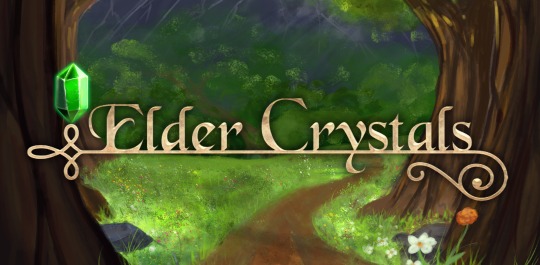
When the gate opens, love and beauty will return to the world, and we will once again live in his perfect light. He's been gone for a long time, but his return is upon us. Let us praise his name and rejoice!

The Elder Crystals is a fantasy game set in the world of Sekherion, and its story begins in a place known as the Secluded Valley. The valley has been your home for nineteen years, and you have always seen it as a safe place.
All of that changes when you wake up in a forsaken cavern, right next to a large Crystal Gate, and you realize you were kidnapped and left for dead. Thankfully, you're not alone. There's a black cat with you, and he/she seems to be trying to lead you to safety.
As you explore the cavern, you uncover traces of suspicious activity. There are books and scrolls dating back to the Second Age, there are notes speaking of strange, dark rituals, and then, there is the Crystal Gate itself. You've never seen anything like it in the valley, and you can't help but wonder why it's there.
Is the Crystal Gate keeping you from what's inside, or is it keeping whatever's inside from getting out?

Play as male, female, or nonbinary.
Play as a member of one of eight races, with each one having a unique racial trait.
Customize your appearance, personality, and sexual orientation.
Romance a wizard astronomer, a dutiful monk, a quirky witch, a noble archer, a mysterious mercenary, or an arrogant elf from the outside world.
Build your stats and develop your skills, and see how your choices change your experience.
Choose your weapon and collect different types of equipment.
Explore three different types of magic.
Customize your dragon familiar.
Complete quests and track them in your personal journal.
Collect books to unlock a unique scene at the end of the game.
Protect your town from bandits, cultists, and the undead.
Join forces with an old wizard, an ancient lich, or a talking tree.
Learn the truth about your mother and her unusual connection to the Elder Crystals, and discover what happened when the valley was cut off from the outside world!

THE ASTRONOMER
Amedu (m) or Ameda (f) | Islander, human | 19yo | Wizard
Trope: MC's childhood friend.
Personality: relaxed, open-minded, esoteric, calm.
PINTEREST | BLURB
THE MONK
Nelfas (m) or Nelfasu (f) | Saryel/Southerner, human | 22yo | Monk
Trope: Voice of reason.
Personality: calm, detached, rational, unemotional, wise.
PINTEREST | BLURB
THE NOBLE ARCHER
Darion (m) or Daria (f) | Southerner, human | 20yo | Archer
Trope: Arranged engagement.
Personality: sarcastic, rebellious, cunning, evasive, cocky, loud.
PINTEREST | BLURB
THE WITCHLING
Cerien (m) or Cerina (f) | Northerner, human | 18yo | Witch
Trope: That strange person no one knows anything about. Someone with a secret crush.
Personality: obsessive, quirky, individualistic, unorthodox, shy.
PINTEREST | BLURB
THE MERCENARY
Xarien (m) or Xarina (f) | Northerner, human | 25yo | Battlemage
Trope: New person in town. Someone with a lot of inner demons.
Personality: deceitful, cunning, daring, jealous, ruthless.
PINTEREST | BLURB
THE GUARDIAN*
Qen (m) | Primeval Elf | 5506yo | Guardian/Holy Warrior
Trope: Someone with a connection to MC's family.
Personality: dutiful, arrogant, lawful, tactful, lonely.
PINTEREST | BLURB
*Unlike the other five love interests, Qen's gender is set to male, and he can only be romanced by male characters.
Art credits: Izabela Oliwia.
FORUM | DEMO | TUMBLR | PINTEREST | PATREON
#The Elder Crystals#TEC#TEC Synopsis#darielivalyen#IF#Choice of Games#Hosted Games#Synopsis#Choicescript#Interactive Fiction#Announcment#WIP
421 notes
·
View notes
Text


Davis Motomiya & Ken ichijoji BT17-084, and Imperialdramon: Paladin Mode Ace BT17-077 by toriyufu from BT-17 Booster Secret Crisis
#digimon#digimon tcg#digimon card game#digica#デジカ#digisafe#BT17#Digimon Adventure 02#Davis Motomiya#Daisuke Motomiya#Ken Ichijoji#Imperialdramon#Paladin Mode#Ace Digimon#toriyufu#digimon card#tamer card#color: blue#color: green#color: white#Lv7#type: vaccine#trait: Ancient Holy Warrior#num: 03
76 notes
·
View notes
Text
Gwyneth Berdara: Headcanons
@gwynweek2022 Day 2: Favorite Character Traits

Warrior, scholar, & total sweetheart
Imagine Gwyn knocking Azriel out during a fierce hand-to-hand spar. Total lights out, can’t move, flat on his ass, loud *thud* type of knockout. Everyone suddenly stops training and stares at her.
The priestesses are jaw dropped. Cassian is in awe. Nesta mutters a “holy shit” and Emerie a “wow”
Azriel, too stunned, just lays on the floor for a little bit longer looking up at her with so much pride
Gwyn mortified and suddenly full of panic because oh my god she just hurt the the Shadowsinger.
Azriel suddenly laughing. A sweet joyous sound. He picks himself up, looks at Gwyn with such admiration and slowly reaches for her fist and lifts it above her triumphantly.
Gwyneth Berdara, ladies and gentleman.
After long and tedious nights in the library, Gwyn finishes her scholarly research on the Valkyries, Merril finishes the book, and Gwyn gets to add to special acknowledgments.
Gwyn writes a tender, simple thank you to Nesta, Emerie, Cassian and Azriel. The ones who made this possible for her. The ones who helped show her true power. The ones who didn’t let her break. The ones who made her strong.
There’s a celebration dinner. She gives a little speech. Shows off the book. And acts like it’s not a big deal.
Cassian loudly and obnoxiously makes sure that is in fact a major deal. He practically tackles her. Nesta and Emerie are emotional and squeeze her in big hugs. Once recovered, Gwyn goes and hugs Azriel. He pretends it isn’t warm and lovely. He ignores that they fit perfectly together. When she whispers “Thank you. Especially you.” Azriel pretends that he can still breath. And everytime he looks at her, Azriel pretends that his heart isn’t slamming in his chest.
Gwyn at 7am and at midnight with the brightest smile and a voice that can light up the day
She’s slow to anger, but once someone crosses or underestimates her, hell truly hath no fury
Analytical -- a good decision is one that’s made after thinking it over properly (and sending herself into a panic overthinking it)
Ambitious and just a teeny bit extremely aggressive
“She’s perfect. I love her”- Me, Nesta Archeron, Emerie, Azriel, you, & literally everyone
Practical, patient, and uses her head
A quick learner and is good! at! everything! examples:
Game night? The undefeated Monopoly champion - sends Cass to jail 5x's and makes Azriel sexually frustrated
Knitting? Here's a matching scarf, hat, and gloves with a hand-embroidered "A" surrounded with blue stars
Making dinner? Here's a gourmet burger with a toasted taleggio cheese crisp, mango chutney, black truffle aioli on a brioche bun.
She loves the smell of fresh parchment and leather
An old soul who knows old loves songs & ancient poems
A deep sense of curiosity for anything and everything around her
Gwyn asking the real questions:
So, what is the optimal dagger length? What are the merits of a friends-to-lovers romance versus an enemies-to-lovers in a maintaining a healthy relationship? Do bigger wingspans truly mean bigger...? Why is the Night Court divided into three sociopolitical factions? How are the Illyrians racially and economically oppressed? Do you sing? So, what actually is Mor’s truth power? What hair potions does Cassian use? What are the imperialist downfalls of a High King monarchy? But really though, do you sing?
The singing and wingspan questions are of particular interest. She has her theories. It’s best to be thorough and conduct extensive analysis
Nesta & Azriel have the BIGGEST weakness for her. Once she gives them the puppy dogs eyes they are goners.
Nesta: She’s my best friend.
Azriel: *aggressively shows off wrist with friendship bracelet*
Nesta: She’s my wife.
Azriel: *dramatically waves arms at the mating bond*
If Gwyn asked them to jump off a cliff they would do it twice.
The Favorite™ (sorry Cassian)
She is the giggliest, cutest, happiest drunk
She becomes a trailblazer, unafraid and marching forward to the wide road ahead.
Despite all the pain she has endured, Gwyn keeps on burning bright. She is beautiful, brilliant, and believes in the good around her.
#UGH WE LOVE HER#literal perfection#Nesta and Emerie lemme join the Gwyn Protection Squad#Az is gonna be one lucky SOB#gwynweek2022#did anyone get my Parks & Rec reference#gwyneth berdara#gwyn berdara#gwyn acotar#gwyn acosf#valkyries#gwynriel#hehe
269 notes
·
View notes
Text
SJM's pinterest board. ACOTAR 6/7.
(No conclusion just suspicious stuff lmao)
Here's a photo i found on SJM's ACOTAR pinterest board:

THE MOIRAI (Moirae) were the three goddesses of fate who personified the inescapable destiny of man (and women). The role of the Moirai was to ensure that every being, mortal and divine, lived out their destiny as it was assigned to them by the laws of the universe.
In nearly all mythologies the three Fates, rulers of the past, present and future, are represented and many believe they symbolize the Triple Goddess, Virgin, Mother and Crone (Creator, Preserver and Destroyer).
In Greek mythology, the Moirai—often known in English as the Fates—were the white-robed incarnations of destiny.
“There were at least three dozen priestesses who worked and researched and healed here, though it was nearly impossible to count them when they all wore the same pale robes and so many kept the hoods over their faces.”
Clotho (/ˈkloʊθoʊ/, Greek Κλωθώ, [klɔːtʰɔ̌ː], "spinner") spun the thread of life from her distaff onto her spindle.
(Clotho: the mute priestess at the library)
Lachesis (/ˈlækɪsɪs/, Greek Λάχεσις, [lákʰesis], "allotter" or drawer of lots) measured the thread of life allotted to each person with her measuring rod.
Atropos (/ˈætrəpɒs/, Greek Ἄτροπος, [átropos], "inexorable" or "inevitable", literally "unturning",[13] sometimes called Aisa) was the cutter of the thread of life. She chose the manner of each person's death; and when their time was come, she cut their life-thread with "her abhorred shears". The figure who came to be known as Atropos had her origins in the pre-Greek Mycenaean religion as a daemon or spirit called Aisa. Another important Mycenaean philosophy stressed the subjugation of all events or actions to destiny and the acceptance of the inevitability of the natural order of things; today this is known as fatalism.
The Morrígan or Mórrígan, also known as Morrígu, is a figure from Irish mythology. The name is Mór-Ríoghain in Modern Irish, and it has been translated as "great queen" or "phantom queen".
The Morrígan is mainly associated with war and fate, especially with foretelling doom, death or victory in battle. In this role she often appears as a crow, the badb.[1] She incites warriors to battle and can help bring about victory over their enemies. The Morrígan encourages warriors to do brave deeds, strikes fear into their enemies, and is portrayed washing the bloodstained clothes of those fated to die.[2][3] She is most frequently seen as a goddess of battle and war and has also been seen as a manifestation of the earth- and sovereignty-goddess,[4][5] chiefly representing the goddess's role as guardian of the territory and its people.[6][7]
Mor may derive from an Indo-European root connoting terror, monstrousness cognate with the Old English maere (which survives in the modern English word "nightmare") and the Scandinavian mara and the Old East Slavic "mara" ("nightmare");[14] while rígan translates as "queen".[15][16] This etymological sequence can be reconstructed in the Proto-Celtic language as *Moro-rīganī-s.[17][18] Accordingly, Morrígan is often translated as "Phantom Queen".[16] This is the derivation generally favoured in current scholarship.[19]
The Morrígan is often considered a triple goddess, but this triple nature is ambiguous and inconsistent. The triple appearances are partially due to the Celtic significance of threeness.
(Three is a VERY common number in acotar (might make a whole other post on that))
Could Mor be one of the fates or even something more powerful than them, could she have a bigger part than we thought in the next story with Koschei ?
In the Republic of Plato, the three Moirai sing in unison with the music of the Seirenes. The term "siren song" refers to an appeal that is hard to resist but that, if heeded, will lead to a bad conclusion.
In Greek mythology, the Sirens (Ancient Greek: plural: Seirênes) were dangerous creatures, who lured nearby sailors with their enchanting music and singing voices to shipwreck on the rocky coast of their island. It is also said that they can even charm the winds.
i bet your thinking where tf is this looney going with this....well,
i also found this photo:

Celtic Mythology The GWRAGEDD ANNWN [wives of the underworld]were lake-sirens in Wales. These lovely creatures are known to choose mortal men as their husbands. One legend has it that they live in a sunken city in one of the many lakes in Wales. People claim to have seen towers under water and heard the chiming of bells. In earlier times, there used to be a door in a rock and those who dared enter through it came into a beautiful garden situated on an island in the middle of a lake. In this garden there were luscious fruits, beautiful flowers and the loveliest music, besides many other wonders. Those brave enough to enter were welcomed by the Gwragedd Annwn and were invited to stay as long as they wanted, on the condition that they never took anything back from the garden. One visitor ignored the rule and took a flower home with him. As soon as he left the island, the flower disappeared and he fell unconscious to the ground. From that day on, the door has been firmly closed and none has ever passed through it again.
“My grandmother was a river-nymph who seduced a High Fae male from the Autumn Court.”
Gwyn believes her grandmother to be a river-nymph. Is it possible that she was not but instead a lake siren? We know that Gwyn and Catrin's names are welsh (Lake-Sirens are found in wales) and the spring court has many ties to welsh mythology so is it really that far fetched?
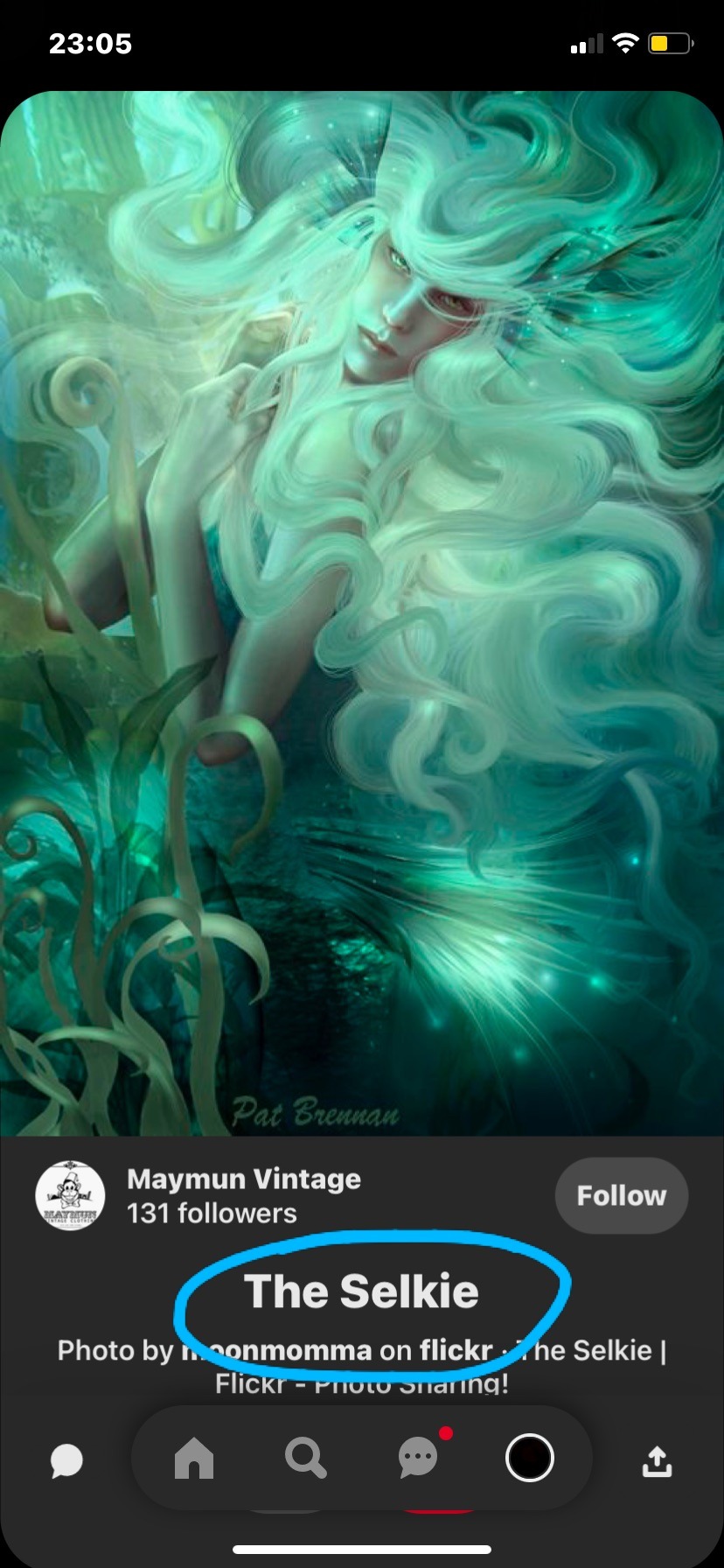
In Celtic and Norse mythology, selkies (also spelled silkies, sylkies, selchies) or selkie folk (Scots: selkie fowk) meaning "seal folk"[a] are mythological beings capable of therianthropy, changing from seal to human form by shedding their skin. They are found in folktales and mythology originating from the Northern Isles of Scotland.
To further back up this, here is another photo of a Selkie woman on SJM's pinterest.
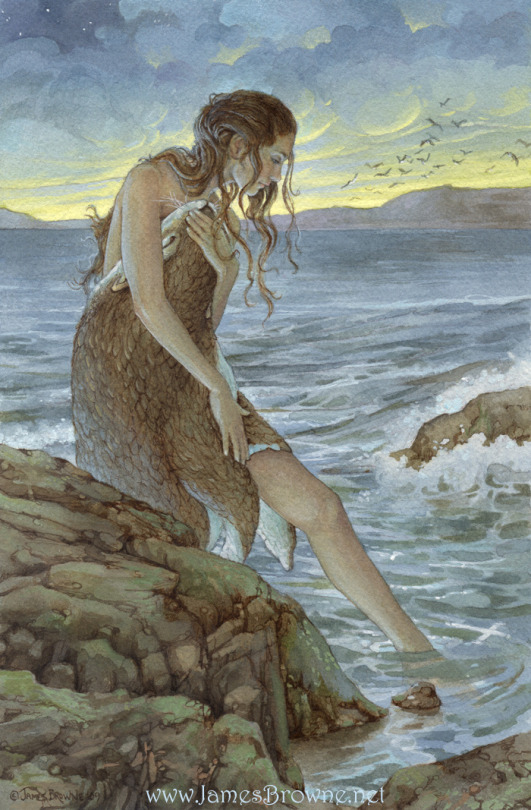
In David Thomson's book The People of the Sea, which chronicles the extensive legends surrounding the Grey Seal within the folklore of rural Scottish and Irish communities, it is the children of male selkies and human women that have webbed toes and fingers. When the webbing is cut, a rough and rigid growth takes its place.
Children born between man and seal-folk may have webbed hands, as in the case of the Shetland mermaid whose children had "a sort of web between their fingers",[25] or "Ursilla" rumoured to have children sired by a male selkie, such that the children had to have the webbing between their fingers and toes made of horny material clipped away intermittently.
“My twin had the webbed fingers of the nymphs—I don’t.”
Once again we see that Catrin posses traits of these water-creatures.
Keep in mind SJM has this on her board - The cover of Celtic folktales which has one story in particular of a 'sea-maiden' whom makes a deal with a mortal man.
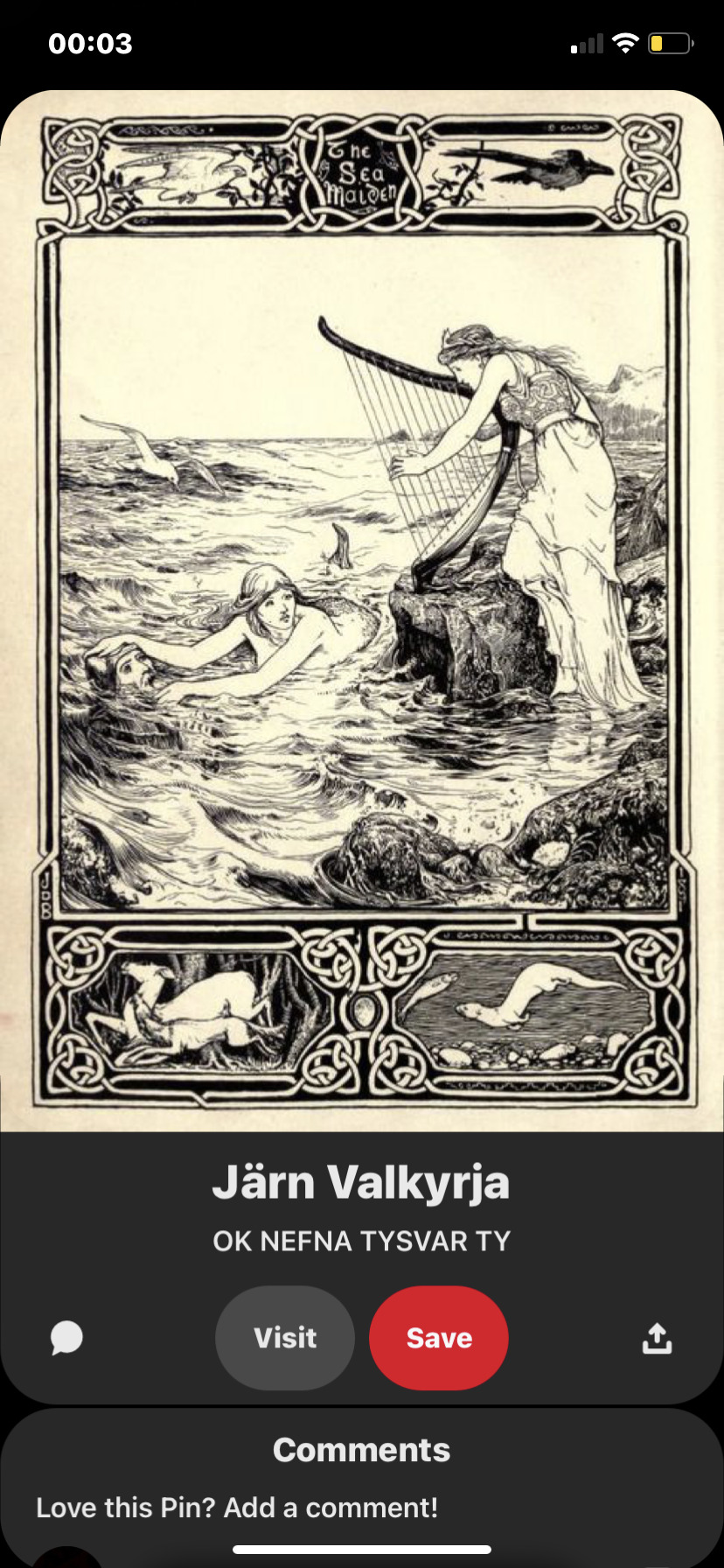
I proceeded to continue searching through the board and found this:
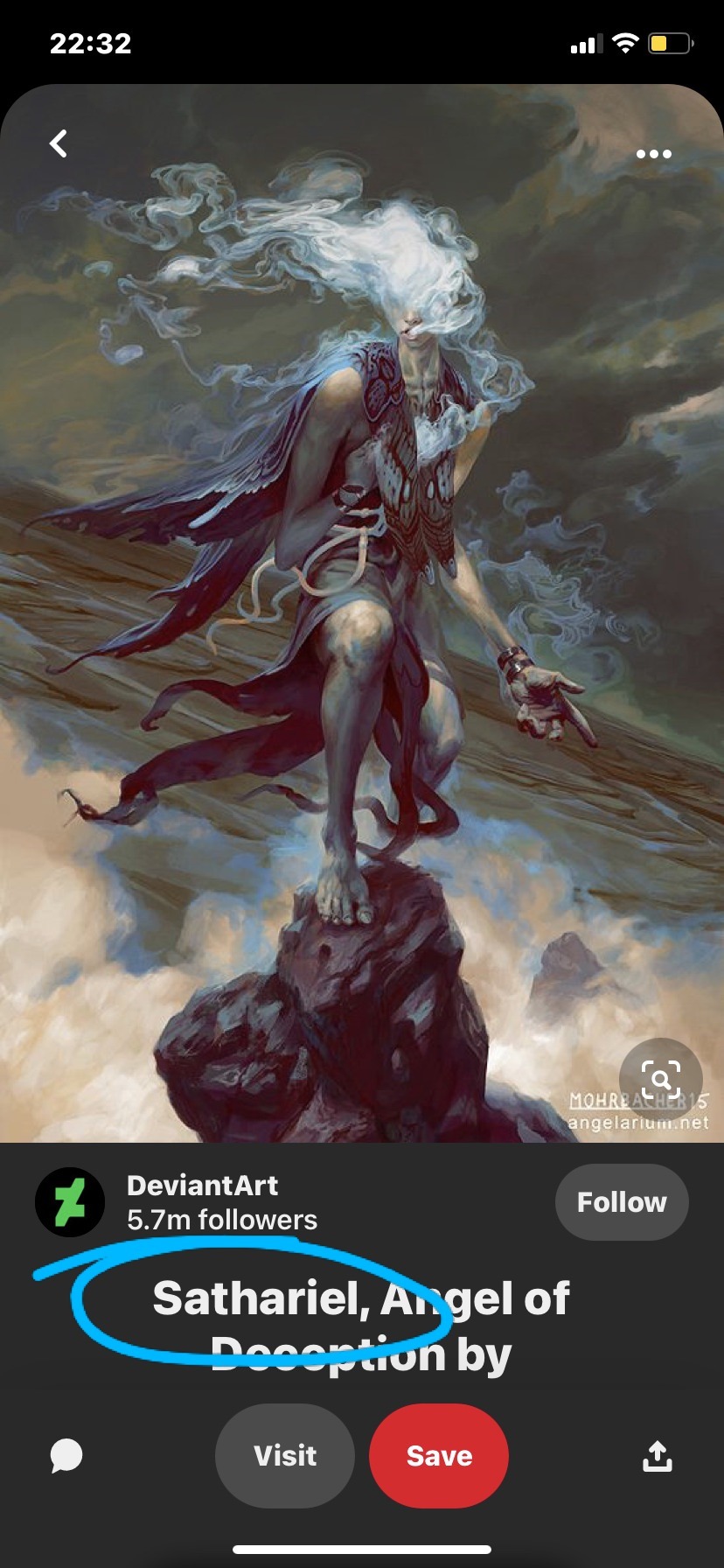
Sathariel (Hebrew סתריאל, Greek: Σαθιήλ) is one of the Qliphoth, corresponding to the Sephirah Binah on the kabbalistic Tree of life. It represents the Concealment of God, which hides the face of Mercy. The form of the demons attached to this Qliphah are of black veiled heads with horns, with hideous eyes seen through the veil, followed by evil centaurs.
'veiled heads with horns'
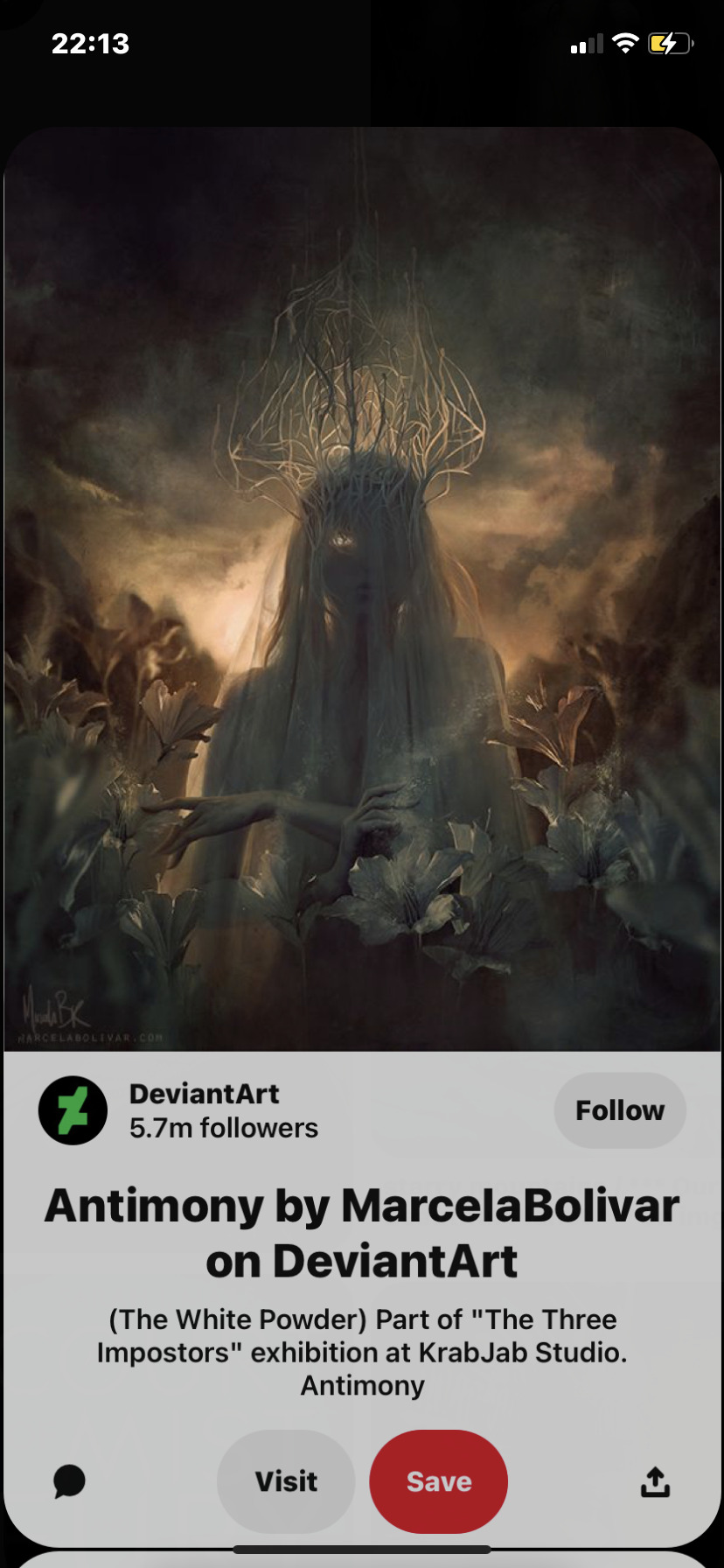
The Qliphoth are the shadow of the Sephirot, the chaotic force that exists when the Sephirah is unbalanced. Binah is the Sephirah that gives birth to form, the great mother of the cosmos, the eternal womb. Through her, the spiritual energy of Keter and Chokmah are woven into the matrix that eventually becomes matter.
In Jewish Kabbalistic cosmology of Isaac Luria, the qlippot are metaphorical "shells" surrounding holiness. They are spiritual obstacles receiving their existence from God only in an external, rather than internal manner.
Quiphoth (shadow of sephriot) = Shadowsinger
"shells" surrounding holiness = The shadows protected Azriel
They emerge in the descending seder hishtalshelus (Chain of Being) through Tzimtzum (contraction of the Divine Ohr), as part of the purpose of Creation.
Sathariel had black feathers on his wings and his body was shrouded in darkness.
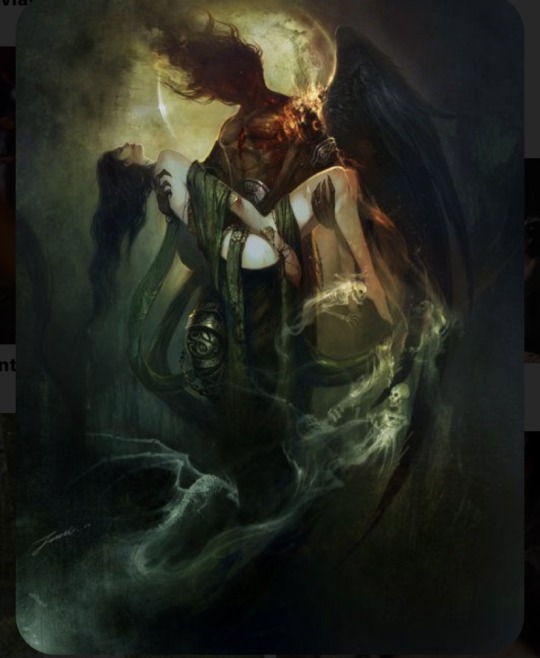
Honestly idk where tf im going with this 😩😩
I've put in far too much effort to delete it so i apologise if you've gotten all this way to be disappointed but
Conclusion:
Mor =/≠ Three fates
Gwyn = Heritage is sus? could be related to some interesting people
Azriel = Sathariel ?
If anyone has ideas to add pleaseeee tell me lol
i'll probably update this when i can be bothered
(FYI i love Gwyn and i'm not saying she's a siren or luring anyone but you've got to admit her grandmother is a sus lmao, especially with half the shit on SJM's pinterest.)
#i have not slept#this makes zero sense#acotar#azriel#azriel x gwyn#gwynriel#gwyneth berdara#azriel berdara#morrigan#acotar theory#acotar 6#acowaf#acomaf#acofas#acosf#a court of frost and starlight#a court of mist and fury#a court of silver flames#a court of wings and ruin#a court of thorns and roses
82 notes
·
View notes
Text
The Contendings of History and Seth
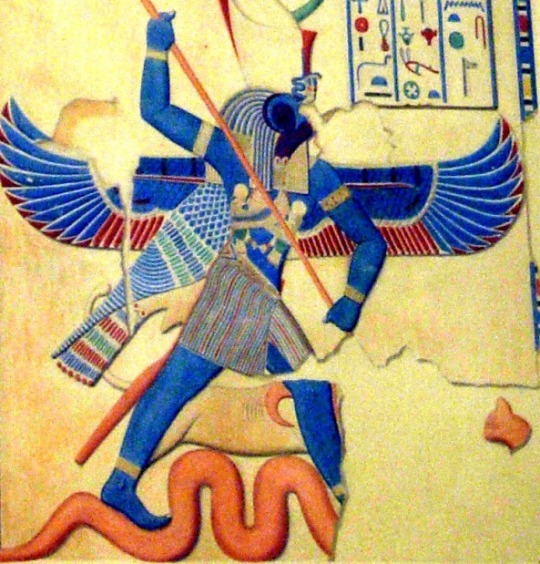
Seth as a serpent-slayer (MET) It's safe to say that the myth of Osiris is one of the only non-Greek myths to enjoy a comparable degree of recognition in modern popculture. There are few direct adaptations, sure, but the core narrative is well known, and as a result works themed after ancient Egypt use Seth as a villain almost without fail if only the premise allows the use of fantastical elements. However, in this article I will instead examine the other side of Seth, and especially his role as a protagonist of myths in his own right, including the historical circumstances of this development. While I mostly want to introduce you to a little known but fascinating world of heroic(?) portrayals of Seth, naturally I will also cover Seth's later loss of relevance and complete vilification to explain why it survived as the dominant tradition.
Early history of Seth
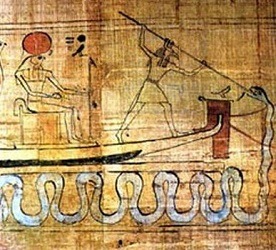
Seth protecting Ra from Apep (wikimedia commons) From the dawn of recorded history Seth's status in Egyptian religion was ambivalent, and it continues to be a topic of heated debate among researchers what degree of popularity he enjoyed in particular very early on. Some aspects of Seth character, like his evident interest in both men and women and whether it reflects broader Egyptian cultural norms (or if it’s merely yet another way in which Seth was an outsider among gods and men, as the author of the first monograph dealing with Seth proposed in the 1960s) are likewise a hotly debated topic. Seth was associated with many animals, such as the hippopotamus and the crocodile, but his main symbol is the sha or “Seth animal” which is regarded as either a mystery or a fictional creation, and in Egyptian texts inhabits zones inhospitable to humans. Seth was called “the god of confusion” by Herman Te Velde (the first writer to dedicate a monograph to him) and while this opinion has been since called into question, it is undeniable that it’s hard to form a coherent image of him. In addition to various versions of the well known myth mentioned above there are other instances of combat between Seth and Horus (most likely initially a distinct myth combined with the narrative about Osiris’ death and resurrection at a later date) and of Seth as a menace to the established order. Some of the Pyramid Texts present even the human followers of Seth as enemies to be conquered (which is held by some researchers a mythical memory of strife between local kings before the unification of Egypt). . However, there are also texts where Seth is a rightful member of the Ennead; where he and Horus act in harmony as protectors of the ruler; where he assists pharaohs in their resurrection in the afterlife; and even to Seth as one of the gods responsible for returning Osiris to life. A recurring motif in texts dealing with the afterlife in particular is a description of Seth offering a ladder to the dead who can reach some destination themselves. Mentuhotep II of the XI dynasty seemingly had Seth and Hathor depicted behind his throne in art; Hatshepsut described Seth positively as well. Personal names invoking Seth are known, too; and as established by Willam Berg in his studies of a different ambivalent deity, “children are not called after spooks.” Seth's ambiguous character made him ideal to represent The Other in Egyptian culture – the foreigners, especially these arriving from the Levant, their culture, and generally “un-Egyptian” traits. In that capacity, he functioned as an “ambassador” or “minister of foreign affairs,” to put it in modern terms. Or perhaps a foreigner in his own country, so to speak. As a result, he came to be associated with a group of deities which, while part of the official pantheon, had their origin outside Egypt.
The Ramessides and foreign gods
Generally speaking, there were two primary sources for foreign deities incorporated into Egyptian religion: Levantine trade centers like Gebal (Byblos in Lebanon) or Ugarit (Ras Shamra in Syria); and Egypt's vassal/enemy/ally/very occasional ruler Nubia (roughly corresponding to present day Sudan). Libyan influence was smaller, and to my knowledge there is no evidence of any major impact of Egypt's other trading partners (Punt, located near Horn of Africa, and Minoan Crete; the latter absorbed many Egyptian influences instead, though) or enemies (like the Hittites) on religion. The peculiar history of Seth is related to the the first of these areas. Early researchers saw the “Syrian” deities as worshiped at best by slaves or mercenaries – they didn't fit neatly into the image of Egypt presented by some royal inscriptions: an unmovable, unchanging and homogeneous country, a vision as appealing to absolute rulers in the bronze age as it was to many 19th and 20th century researchers. However, the truth was much more complex, and in fact some of the best preserved accounts of foreign cults in Egypt indicate that the process was in no small part related to the pharaohs themselves. For example Ramses II in particular was an enthusiast of Anat, as evidenced by statues he left behind:
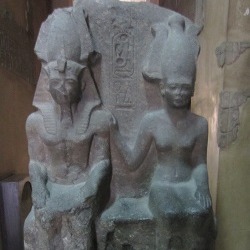
Ramses II and Anat (wikimedia commons) He also named his daughter Bint-Anat (“daughter of Anat”) and his favorite pets and possessions bore Anat-derived names too. Not only only Ramses II himself, but the entire XIXth dynasty – the “Ramessides” (a term also applied to the XXth dynasty) - was particularly keen on these imported deities. Curiously, one of its founders was named Seti - “man of Seth,” and Seth was seemingly the tutelary deity of his family. The well known case of Ramses II's red hair might be connected to this – this uncommon trait was associated with Seth. As a result of the Ramessides' rise to power Seth became one of the state gods in Egypt, alongside heavyweights like Amun, Ptah or Ra. However, it's also safe to say that he was popular in everyday cult among commoners, as evidenced by finds from camps for workers partaking in various construction projects.
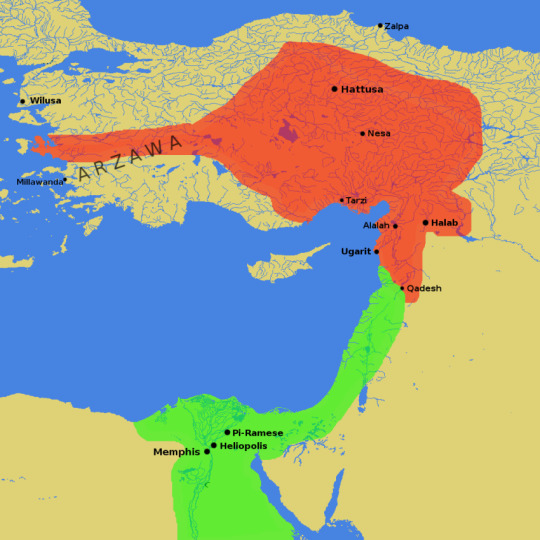
Part of Egypt of the Ramessides at its maximal extent (in green; wikimedia commons) During the discussed period, Egypt was as the peak of its power, both military and cultural; the “other” recognized Egypt's power. Weaker states in the proximity of Egypt paid tribute, while the more distant fellow “superpowers”of the era (the Hittites and the Mitanni, rivals of Egypt in Syria and the Levant, and the more distant Kassite Babylon) bargained with Egypt for dynastic marriages, luxury goods or craftsmen. While some foreign rulers didn't necessarily get that the pharaohs might not want to play by their rules and expressed frustration with that in their letters sometimes (see a particularly funny example below), overall the relations were positive, and resulted in a lot of interchange between cultures.

(source) The incorporation of foreign deities into Egyptian pantheon was a phenomenon distinct both from the well known practice of interpretatio graeca and from the monumental Mesopotamian god lists, and foreign gods were adopted rather selectively. Some researchers propose that the incorporated deities were often chosen because their sphere of influence wasn't covered by any native god. For example, Astarte (more accurately Ashtart or Athtart, considering the Ugaritic orthography; however the Greek spelling is used in literature to refer to the Egyptian version and I'll stick to that) was associated with horses and chariot warfare. As the animal wasn't known in Egypt in the formative period of the state, it wasn't among the symbols of any local deity; at the same time chariots were a prominent component of the Egyptian military at the height of its power, and as such required a deity to be put in charge of it. Six deities of broadly “Syrian” origin are usually listed among Egyptian gods in modern scholarly literature: Anat, Astarte, Resheph, Houron, Baal (the Ugaritic weather controlling one) and Qadesh. Of these, four were pretty similar to their original versions. Qadesh is a complex case as it's uncertain if such a deity existed outside Egypt – it's possible she developed as a combination of a divine title (“the holy one”) and the general Egyptian perception of foreign religion. Some scholars in the past asserted she is simply Athirat/Asherah but this interpretation relied on the false premise of Athirat forming a trinity with Anat and Ashtart and the three of them being the only prominent goddesses in cities like Ugarit. There are also curiosities like Chaitau, a god with Egyptian name (“he who appears burning”) but attested only in sources from Levantine cities (though ones written in hieroglyphics) and in magical formulas of similar origin. Baal is the most puzzling case: simply put, it's clear Baal was introduced to Egypt. It's clear Baal was depicted in Egyptian art. It's even clear that Egyptians knew that Anat and Astarte were deities from Baal's circle back at home, and that Baal was tied to a narrative about combat with the sea. And yet, it's not easy to say where the Egyptian reception of Baal ends and where Seth starts. Baal's name was even written with the Seth animal symbol as determinative. When exactly did this identification first occur is unknown: while it would be sensible to assume the Hyksos, a Canaanite group which settled in Egypt and briefly ruled the Nile delta, are responsible, there is some evidence which might indicate this already happened before.
Baal and Seth
Baal was a natural match for Seth: Seth represented the foreigners, Baal was the most popular god of the foreign group most keen on settling in Egypt; Baal has a somewhat unruly character in myths; both rule over storms and have a pronounced warrior character. Additionally, both of them were depicted as enemies of monstrous serpents. Baal was identified with Seth in Egypt, but in turn Seth became more Baal-like too. So-called “Stela of year 400” depicts an entity labeled as Seth more similar in appearance to Baal due to the human face and Levantine, rather than Egyptian, garb:
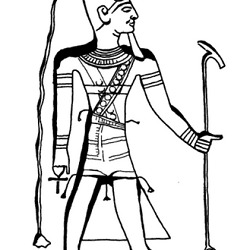
(source) It is well known that the main myth of Baal, in Ugarit the first part of the “Baal cycle,”describes his combat with the sea, personified by the god Yam, seemingly described both as humanoid and serpentine. In Egypt, this narrative was associated with the composite Seth-Baal, and a fragmentary version is recorded in the so-called Astarte papyrus. Curiously, it was actually discovered long before the Baal cycle itself – however, it only became a subject of in depth studies in the wake of the discovery of Ugarit. There are also many similarities to the Hurrian myth “Song of the Sea,” known only from fragments, and to the Song of Hedammu from Hittite archives. While in the Ugaritic version Baal fought the personified Sea against the wishes of the head god El, in the Egyptian version the confrontation happens because the Ennead fears Yam, who threatens to flood the earth and demands tribute, much like the Hurrian Sea. Before Seth properly enters the scene, we learn about how Ptah and Renenutet, a harvest goddess, appeal to his associate Astarte (as already noted before viewed as Ptah's daughter in Egypt), hoping she'll act as a tribute bearer. Astarte is described as a fearsome warrior; however, she is not meant to fight Yam herself, but merely temporarily placate him. She seemingly strips down and brings offerings – this is, once again, closer to the Hurrian than Ugaritic version, where Shaushka, an “Ishtar type” goddess like Astarte, seduces the sea monster Hedammu in a similar way. It is not clear if Yam is interested, though - in fact he appears to question why Astarte isn’t dressed (possibly mocking what must’ve been a humiliating situation for a warrior deity, I’d assume). Eventually, Seth arrives and presumably fights Yam, likely with Astarte's help - the rest of the papyrus is too poorly preserved to decipher, but as indicated by the foreign equivalents Seth and Astarte win. This is confirmed by the Hearst Medical Papyrus, imploring Seth to expel illness from the treated person just like he vanquished the personified Sea. The Ugaritic version of the myth doesn’t include a tribute scene among surviving fragments, though it’s worth pointing out that the Ugaritic Ashtart/Astarte cheers on Baal during his battle against Yam and berates him for not acting quick enough, which is easy to interpret as hostility caused by a similar episode. Many researches assume that it existed among the lost fragments of the Baal Cycle tablets, though this is for now purely speculative. A variant of the myth of Seth and Horus - The Contendings of Horus and Seth - presents a further curious case of Seth-Baal syncretism, this time incorporated into well established Egyptian myth rather than an imported foreign one. Seth and Horus compete for the right to rule after Osiris' death. Ra thinks Seth is the better option to nominate as a successor because Seth killed Apophis on his behalf, but a few other of the elder gods disagree and try to delay the process by insisting to ask various deities to provide their expert opinions. These generally favor Horus much to Ra's annoyance, but he can't go against them so he insults Horus (calling him "feeble and weak-limbed" and criticizing his hygiene) but doesn't stop his rise to power. The semi-humorous portrayal of Ra is rather unusual; in addition to showing annoyance with other gods, at one point he vanishes, and only agrees to return because Hathor lured him out. It seems Horus' mother Isis insults Seth in response to Ra's comments. Seth, offended, refuses to partake in the divine assembly unless Isis leaves; Ra orders that and the gods gather again without her. However, Isis disguises herself and asks Seth who should inherit first, a child or a brother who can provide for himself (and is a foreigner), to which Seth replies that the former; this was a trick, obviously, and Isis holds it as proof that Seth forfeited his right to rule, which Ra accepts. After multiple chaotic tribulations (including the [in]famous lettuce episode as well as Horus decapitating his mother because he decides she doesn't do enough) Horus is re-declared king but Ra, implored by Ptah (otherwise absent from the myth) gives Seth two wives (eg. Anat and Astarte; this solution was suggested already earlier by the gods providing the opinion; some authors question if they are meant to be Seth’s wives or merely allies, much like the relationship between Baal, Anat and Ashtart in Ugarit is considered debatable) and the storm clouds as his new domain. He is to strike fear into hearts of men, but will also get to be treated as if he were Ra's own son. Considering the emphasis on storm and the mention of Anat and Astarte, it's pretty clear to me that Egyptians essentially invented their own Baal backstory meant to integrate the foreign tradition with their own by recasting Baal and Seth as the same entity. The text is however unusual because of its humorous tone – the gods insult each other, act ineptly and all around hardly provide an inspiring example. Perhaps the focus on Seth made this possible. As a final note before I'll move on to times much less prosperous for Seth it's worth to mention that not only Baal but also other foreign gods were at times equated with Seth. The Libyan god Ash was conflated with him in the western oases, while treaties with the Hittites assign the name of Seth to various members of their pantheon, including the Baal-like Tarhunna (equivalent of Hurrian Teshub) but also the sun goddess of Arinna.
Demonization of Seth
While in the late bronze age Seth greatly benefited from his role as a god of foreigners, in later periods this has proven to be his undoing. Egypt couldn't maintain its power forever, and eventually fell to the Assyrians, who showed little respect for local culture and looted Thebes. While the Assyrian domination was only temporary, it severely damaged the country, and a spiritual scapegoat was needed to reconcile the carnage with the idea that Egypt was a land chosen and protected by the gods. The change seemingly occurred under the rule of Psamtik – in a new version of the myth of Seth and Horus, Seth not only lost decisively, but also was punished afterwards, and religious texts spoke of a “rebellion”of Seth. Seth was never associated with Ashur, the head god of the Assyrians, before, but in Egyptian imagination he was blamed for bringing the invaders under “his” command to ravage and subjugate the country. A mythical text has Isis implore Ra to punish Seth for robbing temples, much like the Assyrian armies did. Even later accounts tell various tales about Seth being punished, either gruesomely (a few texts recount massacred of towns belonging to Seth) or humorously (for example in one text Thoth makes him impotent with a spell) and exiled from among gods. There's evidence that the worship of Seth, previously commonplace, came to be abhorred and depictions of Seth were destroyed or altered. A famous example is a Seth statue converted to look like Knhnum or Amun instead:
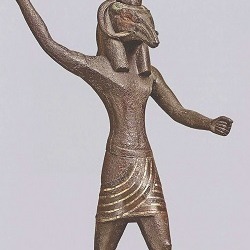
Seth no more (wikimedia commons) A late relief from Edfu, from the Ptolemaic times, seems to indicate that even Seth's role as a guardian of the solar barge was lost: Seth, depicted as a hippopotamus, was defeated by Horus from the solar barge of Re. However, while Apep is usually depicted as huge and menacing, hippo Seth is tiny and pathetic.
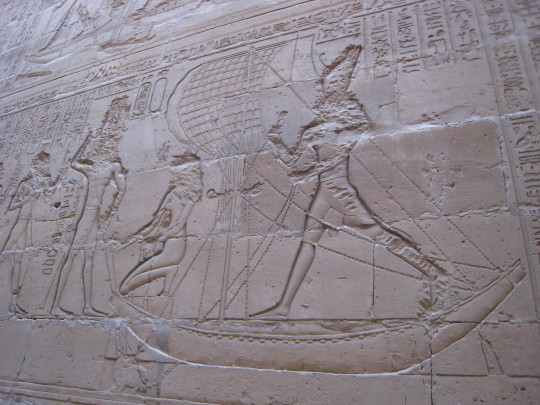
Seth as a tiny hippo representing the forces of chaos (wikimedia commons) Curiously, despite the official policies, which continued under Ptolemaic rule, it seems that until the 2nd century CE, Seth continued to be popular in the Dahkleh oasis, possibly even serving as the main deity there. Sadly due to lack of research I am unable to provide any more detailed information about that.
Closing remarks
Even further demonization of Seth is evident in the fact that the Greeks and Romans referred to Seth as Typhon, leaving no room for ambiguity of interpretation. As the Greek accounts of the late version of Seth were all that was known for centuries due to ability to read hieroglyphic writing vanishing with the advent of new religions, it remains dominant in media today. Perhaps it would be beneficial to leave some room for the serpent-slaying hero Seth hanging out with foreign deities in modern works, though? Surely his peculiar outsider status is even more appealing to modern readers than it was to the public of the Ramesside period.
Bibliography
N. Ayali-Darshan, The Other Version of the Story of the Storm-god’s Combat with the Sea in the Light of Egyptian, Ugaritic, and Hurro-Hittite Texts
G. Beckman, Foreigners in the Ancient Near East
M. Dijkstra, Ishtar seduces the Sea-serpent. A New Join in the Epic of Hedammu (KUB 36, 56+95) and its meaning for the battle between Baal and Yam in Ugaritic Tradition
T. J. Lewis, ʿAthtartu’s Incantations and the Use of Divine Names as Weapons
D. Schorsch and M. T. Wypyski, Seth, "Figure of Mystery"
D. T. Sugimoto (ed.), Transformation of a Goddess. Ishtar – Astarte – Aphrodite - especially the chapters ‘Athtart in Late Bronze Age Syrian Texts by M. S. Smith and Astarte in New Kingdom Egypt: Reconsideration of Her Role and Function by K. Tazawa
H. Te Velde, Seth, God of Confusion: A Study of His Role in Egyptian Mythology and Religion
P. J. Turner, Seth - a misrepresented god in the Ancient Egyptian pantheon? (PhD thesis)
C. Zivie-Coche, Foreign Deities in Egypt
129 notes
·
View notes
Note
Not only do I not regret asking you to "RELEASE THE RAMBLES!", I'm sending you requests for more. Below is a list of questions that I asked @bihansthot , and enjoyed their answers, but because you are so thorough, and answer in such depth, I'm re-asking them to you.
Brace yourself, it's a list. I didnt have time to sort thru them, I just copied and pasted, so if any are questions you already answered before, please feel free to include the links.
"LET US BEGIN!"
---------------------------------------------
In the spirit of potential future writing, I'm trying to find a building that would make a good substitution for Lin Kuei temple.
I've tried looking up ancient Chinese military barracks/forts, and have found some stuff, but is all exterior. Anyone know of any locations (or several I can cobble together) that would make good inspiration fodder?
---------------------------------------------
So, uhm, religion? What's the Lin Kuei's take on that one? I know they are aware of Gods, they team up with/ encounter Raiden all the time, and have literally worked for/against Shinook, so I know they recognize higher powers... but I guess the question is, do they care?
Do they have a religion, or spiritual practice that resembles religion? Or do they have a more practical approach "gods exist, but we just consider them very strong people"?
Which segues into... do they recognize and participate in holidays, or things like birthdays? Or are all their celebrations work related (I.E. successful missions or levels of combat mastery)?
---------------------------------------------
Food. What foods do they normally eat? What foods do they like? What foods don't they like? What foods do they absolutely love so much they'll stop what they're doing to get it?
---------------------------------------------
If you had to match the Lin Kuei with a dynasty, what one would it be? (I know the 2021 movie has the opening in the Ming dynasty, so the Lin Kuei is at least that old, but given that movie Bi Han hasn't aged in 400 years, and was taken is a child, its probably much older) (and also know the game probably cherry picked random Chinese things it liked).
What do you think the Lin Kuei's view on artistic culture (probably not the right word) is? I know they are heavily militaristic, but in the game, Kuai Liang offers Hanzo tea and he properly prepares it the Japanese way, that says they have something of an education other than just related to fighting?
Lastly, in the movie, everything Bi Han does is "for the Lin Kuei", but the Lin Kuei is on Earth (assumedly), and he is working for a guy who wants to enslave Earth, so what do you think the deal is?
---------------------------------------------
Question about the Cryomancers. I know the game lore says that they are supposed to be rare, but I also know that the Lin Kuei have had at least 5 (grandpa, papa, older, and younger Sub Zero, and Frost). 4 of which are part of 3 generations that inherited it even with mixed blood (I'm assuming Mama Sub Zero wasn't Cryomancer since they left her alone).
That's a lot of generations in a row for a rare trait... So do you think the Cryomancers as a group have figured out they're being hunted and have chosen to live in hiding?
---------------------------------------------
Lin Kuei society question? I like writing so I also like world building and I think about these things.
Is Lin Kuei society ever covered? I know there is a Grandmaster, a handful master assassins (Sub Zero's, Sektor, Cyrax, etc) and the movies always have a bunch canon fodder lesser assassins.
And they live in the very isolated Lin Kuei Palace/Temple in Arktika (or wherever it used to be)
But is Lin Kuei (we'll call it "village") ever covered? Do they have willing servants, kidnapped slaves, or a mix of both? Are there women (non fighter women, I know there's Frost) or do they employ strictly male help? If there are women, what's their role, and are there children born there? What about Elderly? What about resources, is everything (from food, clothes, weapons, and the raw materials to create them) grown or manufactured on sight by skilled laborers or do they import/interact with the outside world? How vicious or civil is this society, could you be killed for looking at Sektor wrong or do they value your services to a degree? What's the degree? This is obviously a combat culture, but is everyone expected to know martial arts of some variety, is it optional, or do they prohibit it among the servants/slaves? How strict are they on things like clothing, food, alcohol, drugs, "luxuries", or pleasures? Money? If they interact with the world do they recognize and use $$ currency, commodity currency, or a mixture? Internally are the Lin Kuei payed or just provided for? What about illness or injury, if you're not a master and it a serious injury/illness are you taken care of or do they just give you a quick death?
Etc. That's all the questions I can think of, but please feel free to answer questions I didn't ask, if you think of anything else.
Thank you for this wonderful list to talk about! I’m gonna split the answer into smaller parts, for better focusing on each aspect but also so I don’t feel bad for keeping you waiting for ages, lol. For now let’s focus on asks about the religion!
So good questions! I do think they have some spiritual practice(s) because in martial arts the state of a mind is as important as the physical body and religion is one of many ways to shape someone’s mindset from a young age. I do, however, think that Lin Kuei does not worship the gods. They are aware that the gods exist (with Raiden as the thorn in the side) and may even respect their supernatural powers and battle skills but it never has stopped Lin Kuei from desecrating holy places, murdering people and stealing stuff for the best price. So, it seems to me that whatever religion the members of the clan follow, by nature it is rooted in nontheism.
Of course, there is also a chance that Lin Kuei worships some forgotten deity or deities (as a remnant of their ancient connections with Outworld / realms conquered and destroyed by Shao Kahn?) or may even practice ancestor worship which seems like a good way to uphold a widely understood tradition that plays an important role in the discussed community.
The closest thing to religious practice was seen in Mortal Kombat X, when Sub-Zero and his warriors seemed to pray together before statue of god / deity / ancestor / legendary warrior / personalized thing they value the most (sadly, my knowledge about Asian religious practices or faiths is very limited so I don’t have idea if the statue is supposed to represent any real god/religious symbol).
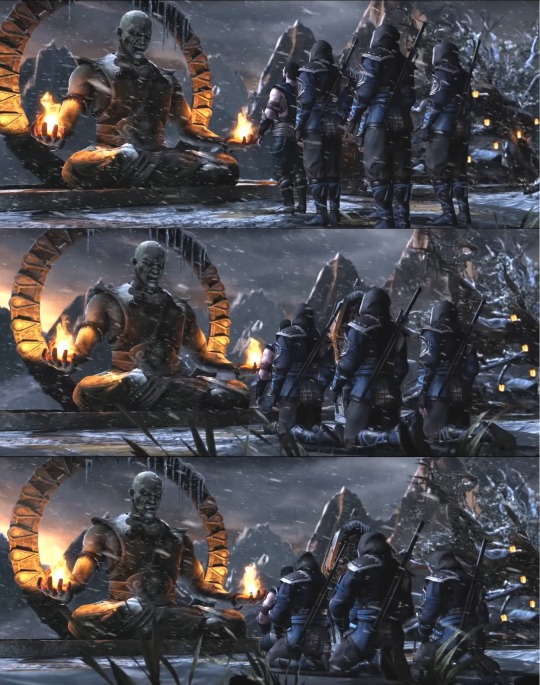
At the same time, it could be just a bluff since Grandmaster was aware of Cage’s team infiltrating the Lin Kuei territory and used this moment to lure them into a trap. Additionally, Mortal Kombat X comics presented once Kuai Liang sitting before the same statue albeit in a completely different (devoid of reverence?) position.
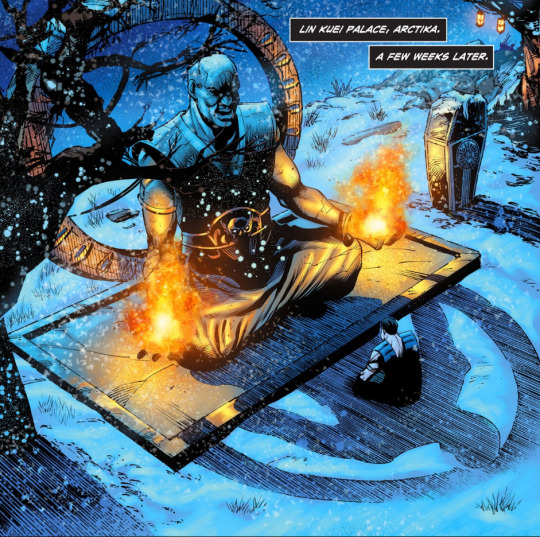
Of course, if we take into account Mortal Kombat Armageddon, the game states that Lin Kuei Temple placed in Arctika was actually once the Temple of Delia (the great sorceress & wife of god Argus) that at some point get abandoned and re-used by Sub-Zero’s clan.
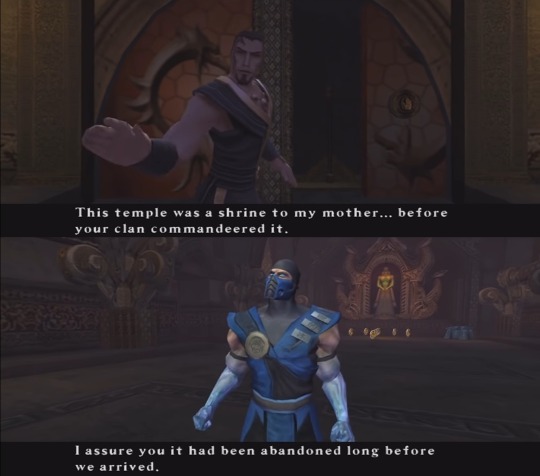
(In the background, we can see a statue of Delia that Lin Kuei does not worship but did not remove for whatever reason. Mixing both old and new games, we can only wonder if MKX!statue is also the remnant of someone else's faith/religion?)
Beside that, Kuai Liang was pretty vocal about Lin Kuei not worshipping the Elder Gods, what was seen in MK11’s intro dialogue with Cetrion
Sub-Zero: The Lin Kuei do not worship the Elder Gods.
Cetrion: We seek gratitude, not worship.
Sub-Zero: I see no distinction.
and personally did not have any reason to pray to the goddess:
Sub-Zero: Why should I pray to you?
Cetrion: Why does a bird flap its wings?
Sub-Zero: I asked a simple question.
In all fairness, in MK11 Kuai Liang seems the most passive-aggressive toward the Elder God while Frost is focused on her ambitions and Noob!Bi-Han just wants to be left alone when bothered by Cetrion. Similar thing happens toward Raiden. Despite gratitude for saving him, Kuai Liang does not spare the god criticism (can’t serve both Elder Gods and Earthrealm, isn’t fit for his role of protector) and in MKX outright says he does not fear divine beings:
Raiden: Sub-Zero...
Sub-Zero: I fear no gods, Raiden.
Raiden': That's why you shall lose.
Surprisingly, Kuai Liang’s interaction with MK11!Fujin sounds less accusing than with Raiden and Cetrion and it is connected closely to their ties with Bi-Han. And maybe Kuai Liang did seek in the past Fujin and other elements to make a peace with them, like he planned to do so in Mortal Kombat 4 Limited comics?
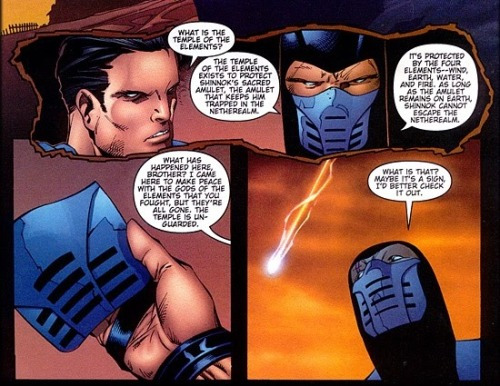
"I came here to make peace with the gods of the elements that you fought [...]"
Anyway, the accusingly behaviour toward Raiden and Cetrion could be just Kuai Liang’s personal dislike for gods and serious authority issues, which makes sense considering how much he suffered because of their meddling and conflicts.
But honestly?
The available examples of Lin Kuei attitude toward gods, demigods and supernatural beings suggest how little the warriors - especially cryomancers - care for them.
Like, we have Bi-Han in Mythologies, who asked Quan Chi about details of mission:
Sub-Zero: If it's so precious, why don't you get it yourself?
Quan Chi: I cannot enter the temple until the four elements within its walls have been defeated. And I am not on the best of terms with the gods of your realm... especially your god of thunder.
Sub-Zero: Tell me about these elements.
Quan Chi outright said he and earthrealm gods weren’t friends and Bi-Han, reading between the lines, could get the idea that he may end on bad terms with Thunder God. Yet he was interested only in elements (lesser gods than protector of realm?) guarding the temple.
Then Bi-Han beat down four demigods and met a displeased Raiden after Quan Chi got the Shinnok Amulet. His reaction? No fear, like meeting an angry god was a normal occurrence.
Rayden: Do you realize what you've done??
Sub-Zero: I was just earning my living.
Rayden: Your clan's ignorance and greed will cost this entire realm. You must now set things straight.
Sub-Zero: Quan Chi could simply be a lunatic sorcerer. I've never heard of an elder god named Shinnok or of a place called the Netherrealm.
Rayden: Well, you'd better start believing in both, because you're going to the Netherrealm and you're going to bring the amulet back. We must act quickly. I have no dominion in the Netherrealm... You are reality's only hope.
Sub-Zero: I'll do it, Thunder God... but only because I have no choice.
And once he came back from Netherrealm, where he was fixing what he messed up in the first place on Raiden’s order, his abrasive attitude did not change much:
Sub-Zero: Here... the amulet.
Rayden: Impressive, Sub-Zero. Perhaps you will reconcile your reckless past after all.
Sub-Zero: That's it? Not even a thank you?
Of course, to some degree Raiden’s words did have an impact on Bi-Han but even the god’s warning about his soul tainted with evil did not stop him from coming back to Lin Kuei. Bi-Han’s attitude and/or approach to gods seems to change somehow once he was reborn as Noob, but that is a different matter for different times.
Anyway, Mythologies!Bi-Han and MK11!Noob act less aggressive toward gods than Kuai Liang. But then we have Sub-Zero from from the MK novel by Jeff Rovin, who not only is not afraid of gods but outright insult them:
“Wait! Be warned, Shang Tsung. He is cursed!”
“Cursed? By whom?”
Ruthay wailed, “By the immortal Yu.”
Shang Tsung felt cold spiders crawl up his spine. “The demigod Yu?”
“Yes… he who is said to dwell in the underground caverns of Horse Ear Mountain… which is sacred to the goddess Kuan Lin. He who protects the canals… and the tunnels… and looks after all who use them, human and animal.”
“What did our brash friend do to Yu?”
“He… killed a man,” said Ruthay.
“What man?”
“A toll-taker… one who had given up a life of crime… one who had been a partner of the man… you… seek.”
“And how did that crime come to the attention of the spirit of Yu?” Shang Tsung asked.
“The man was killed… slowly disemboweled with a sword… while accomplices forced his wife and his son to look on! After his murder… the man’s remains… were dumped into a canal!”
Shang Tsung raised an eyebrow. “Is that all? I was expecting something truly terrible!”
“It was!” Ruthay shrieked. “When he disposed of the body… in that way … he profaned one of the sacred waterways… of Yu!”
Shang Tsung smiled now. “Then he is definitely the man I want,” he said. “Anyone who is impudent enough to insult a demigod won’t be afraid to attack a member of the White Lotus Society, or the gods who watch after them. I will send Hamachi, Ruthay. When he nears his goal, see through his eyes and guide him!”
Book!Sub-Zero was impudent enough to insult a demigod which is why he was one of Shang Tsung’s favorites. And to be clear - book!Sub-Zero did not regret insulting the demigod at all. Even more! He found humor in it!:
He dwelt in a cave two hundred feet up the face of a cliff by the sea. The mouth of his home was barely wide enough to accommodate a slender adult, and was accessible only by climbing the sheer wall of rock, a feat that was impossible for most adults and daunting even to the few arachnids and marsupials that tried it.
Maybe some of them were even sent by Yu, he thought with a smirk, little assassins who would chastise me for having spilled blood in his precious canal.
The less abrasive attitude toward gods was shown by Cyrax, who talked a bit with Raiden over Bi-Han’s remains. He wasn’t outright antagonistic but wasn’t overall respectful either. He talked with Thunder God like he would talk with any other human being that wasn’t actually Scorpion. Frankly, from the named Lin Kuei only MK9!Smoke actually addressed Raiden in respectful manner, with proper bow and the name of lord
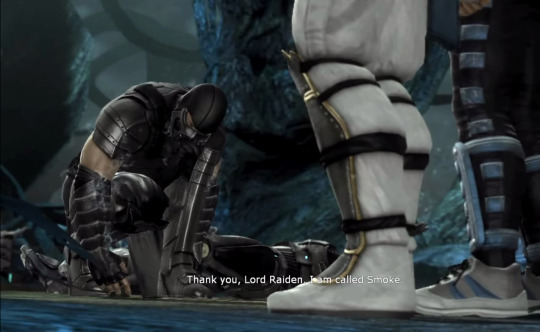
albeit did he do so because he respects the divine beings or just out of gratitude for saving him, hard to tell for sure.
So yeah, it seems like no matter what kind of timeline or age or medium of the story, Lin Kuei does not fear gods nor pray to them. And the clan has a long history of dealing with Raiden, so the Lin Kuei had first-hand experiences with supernatural beings. Somehow, cryomancers are the most impudent warriors when it comes to dealing with or criticizing the gods.
Interestingly, as much as Lin Kuei warriors don’t care for gods, most of the known to us named characters believe to have - and to care - for their own souls. Sektor and MK11!Frost embraced the Cyber Lin Kuei idea but Kuai Liang, Cyrax and Smoke were opposed to C.I. project out for concern for their souls among other things. Even Bi-Han, to some degree became concerned about his soul after trip to Netherrealm.
Believing in souls is usually a sign of belief in the afterlife, albeit after all of them went through (the change into cyborgs, death and change into Revenants) this is less a matter of faith (religion) and more first-hand experiences. And let's not forget that regularly dealing over the centuries with Shang Tsung who steals people's souls on a daily basis makes it really hard to not believe spirits are real.
Also, an interesting matter of Lin Kuei practices that could have a religious/spiritual ground and/or be an example of ancestor worship is the clan’s funeral rites. I don’t think we actually saw any Lin Kuei to bury their own (especially after warrior’s failure?) and for sure MK9!Cyrax and Sektor did not bother to take care of Bi-Han’s remains. However the sources provide examples of Lin Kuei keeping corpses, most likely of their own leaders or warriors.
And so, we could see human remains:
put in two coffins on each side of statue

hidden / kept in a block of ice(?) in chamber of Fallen Lin Kuei in which Frost’s frozen body was also laid, but on the altar
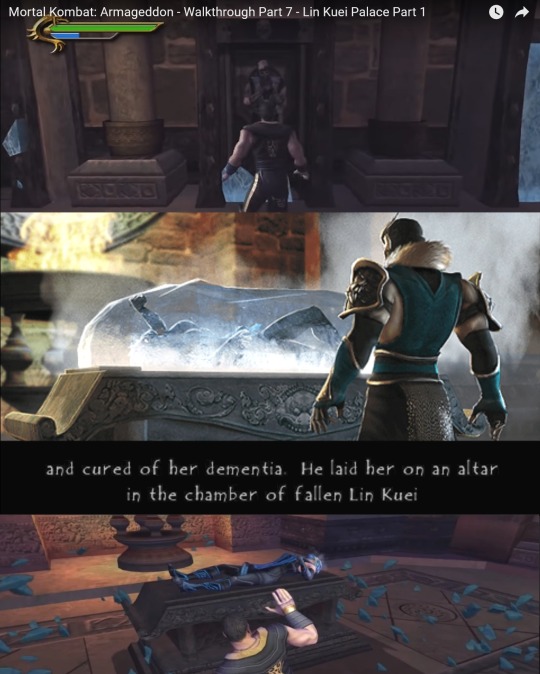
Cyrax’s cyber body was kept and guarded by Sub-Zero (and this is like the only thing that Kuai Liang and Cyber Sektor so far agreed on)
and even Cyber Sektor’s remains, even if just for pragmatic reasons, are kept in what seems to be respectful manner:

It could be just Kuai Liang’s good nature to honor fallen of his clan (I’m still not sure if Lin Kuei Palace is the new place for Sub-Zero’s clan or the ancient hideout) but even in MK Conquest TV series, after Grandmaster was killed by then-currently-Sub-Zero, there was the farewell ceremony with clothes on display (cause there was not much left of body after freezing and shattering) while new leader gave the speech promising to punish the guilty.
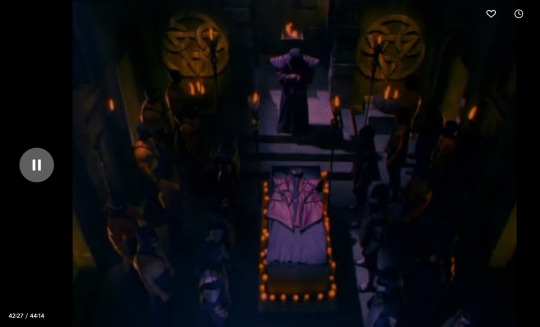
Which makes me think that Lin Kuei did honor their fallen warriors (especially those exceptional, deserving). Such custom and apparently common belief in soul could also support the ancestor worship - both as some ancient, mythical ancestor(s) connecting warriors into one clan (family) and tradition to follow in the footsteps of forefathers (Bi-Han taking place of his father [old timeline] or grandfather [current timeline] or Kuai Liang taking Bi-Han’s place as Sub-Zero).
My general conclusion about Lin Kuei is that its members believe in souls, have respect and use of spiritual matters (meditation?) and maybe ancestor worship. Whatever the religious / spiritual practices they have over the centuries, it is not something they will share, as the Lin Kuei by nature are secretive people who keep personal things mostly for themselves. The people that joined the clan (Cyrax and Smoke) maybe kept their old, eventual religious beliefs but overall, Lin Kuei warriors did not fear, care for nor pray to gods. They may respect god (Raiden, Fujin) as a person but not because of their divine nature. And even that would not stop them from criticizing said god. Which is pretty much how Kuai Liang and Raiden’s relationship looks like. Grandmaster is grateful to Thunder God for saving him but he won’t blindly follow his authority.
(Kuai Liang has serious authority issues, hasn't he?)
As for holidays, I can’t really see Lin Kuei to follow any specific religious (theistic) special day cause they don’t care much for gods in the first place. Unless they worked undercover and needed to act as normal human beings, religious holidays would mean nothing to them. The warriors may however celebrate their mission success, combat mastery or promotion between themselves or in secret, I think. Like, Lin Kuei did forbid friendship because it was considered warrior’s flaw yet we know some members either were blood-related (Kuai Liang, Bi-Han, previous Sub-Zero - father or grandfather, depending on which timeline is correct) or considered each other a family (Kuai Liang and Tomas Vrbada) and most named characters worked in duos so they have both opportunity and knowledge about each other to celebrate important matters. If they managed to remember anything from previous life, that is. Because from ancient to at least Great Kung Lao’s times most(?) adepts were kidnapped from biological families at a really young age (something around 6 years old). And Mythologies: Sub-Zero takes that even further:
Its warriors are chosen at birth to be raised apart from the workings of day to day civilization and are stripped of their former lives. Only the clan knows their existence. Each of them posses certain skills and abilities that set them apart from normal men. These abilities are passed on from generation to generation and honed throughout the experiences of life.
So, celebrating birthdays doesn’t sound like happening much, unless those with family around could allow themselves such luxury. The clan may however celebrate the day of becoming a fully trained and sworn warrior? Or the fallen warriors? Who knows.
Also, something worth thinking about: in Mortal Kombat Conquest TV series, when the Grandmaster presented newly appointed Sub-Zero to the rest of the clan, he “celebrated” the cryomancer's first official performance as the execution of two men who failed their mission. So, yeah, celebration of something special in (old) Lin Kuei does not necessarily mean anything nice.
(The next part of answer most likely will be focused either on food or architecture / origin of Lin Kuei. Let's hope I will get it written sooner than later)
<><> EDIT <><>
RELIGION <> ORIGINS / ARCHITECTURE <> FOOD <> FOR THE LIN KUEI <> ART <> CRYOMANCERS <> LIN KUEI SOCIETY <> MONEY & MATERIAL GOODS
#mortal kombat#my replies#sub zero#bi han#kuai liang#lin kuei#cyrax#long text#smoke#tomas vrbada#cetrion#raiden#lin kuei does not care for gods but may respect spiritual matters#mortal kombat mythologies#mortal kombat 11#mortal kombat x#mortal kombat 9#mortal kombat armageddon#thanks godness for all those people who share their walkthrough plays so i can get the needed details#cryomancers have a serious authority issues don't ya think?#there may be more with older sources but frankly i don#i don't* play much games and focus on the few plus comics and books lol#is smoke... like the only one lin kuei that showed raiden the proper respect? LOL
63 notes
·
View notes